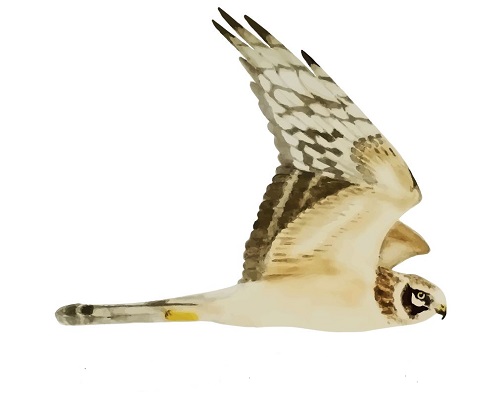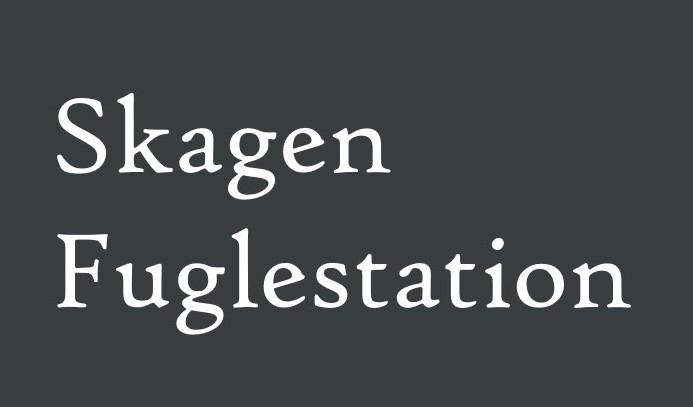Her på Skagen Fuglestations blog bringes korte nyheder i dagbogsformat om hændelser på fuglestationen.
Se indlæg fra måned: feb. (16)mar. (30)apr. (30)maj (31)juni (30)juli (31)aug. (31)sept. (30)okt. (31)nov. (29)dec. (11)
Celebrating the End of the Spring Season Ringing
After a night with only low winds, we had some refreshed hope for our final day of the Spring ringing following the standard protocol.
Simon and I departed the Grå Fyr at 03:00 to go to open the nets for ringing. There were nice weather conditions this morning and when Seán joined us, the mood was good and energy levels high (... no comparison to the ringing yesterday, where the tiredness from the nightly excursion was heavily noticeable ).
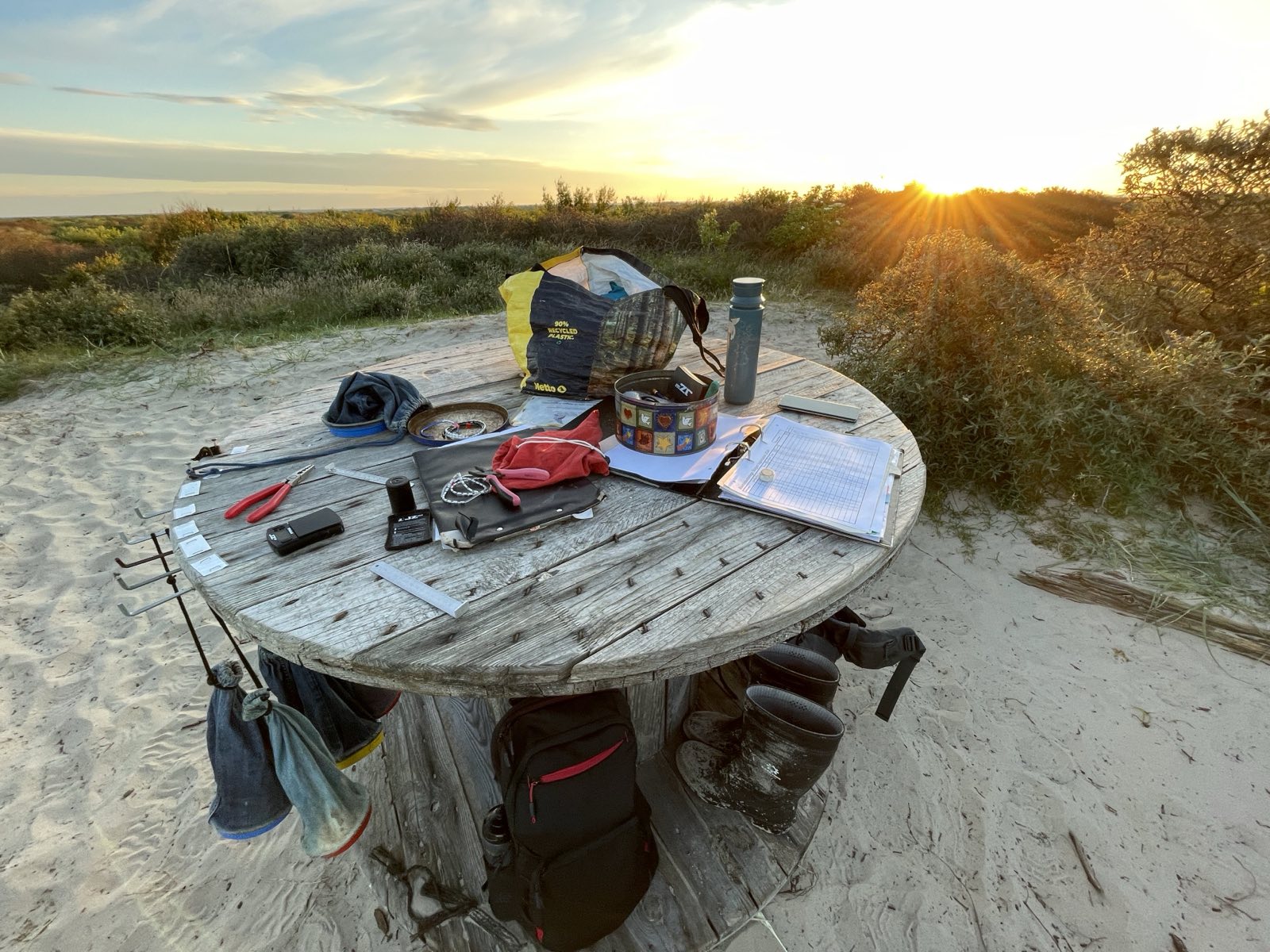
Our outdoor "office" in the morning sun
Since I just recently joined, let me quickly introduce myself: My name is Rika and I am joining the station as a stand-in for a few days. I started ringing birds at CES Vestamager and CES Rungstedlund this year and I am trying to get as much hands-on experience as possible. Therefore, I am very grateful for the opportunity to join the volunteers a Skagen Fuglestation.
We had very low expectations for this last ringing day, especially after the low number of birds in our nets on the previous day. The wind on the day before had also made the extraction of birds from the nets very challenging. However, this day started good, with varied species of birds in the first round and no big extraction challenges. The second round brought us back to Kabeltrommen empty-handed.
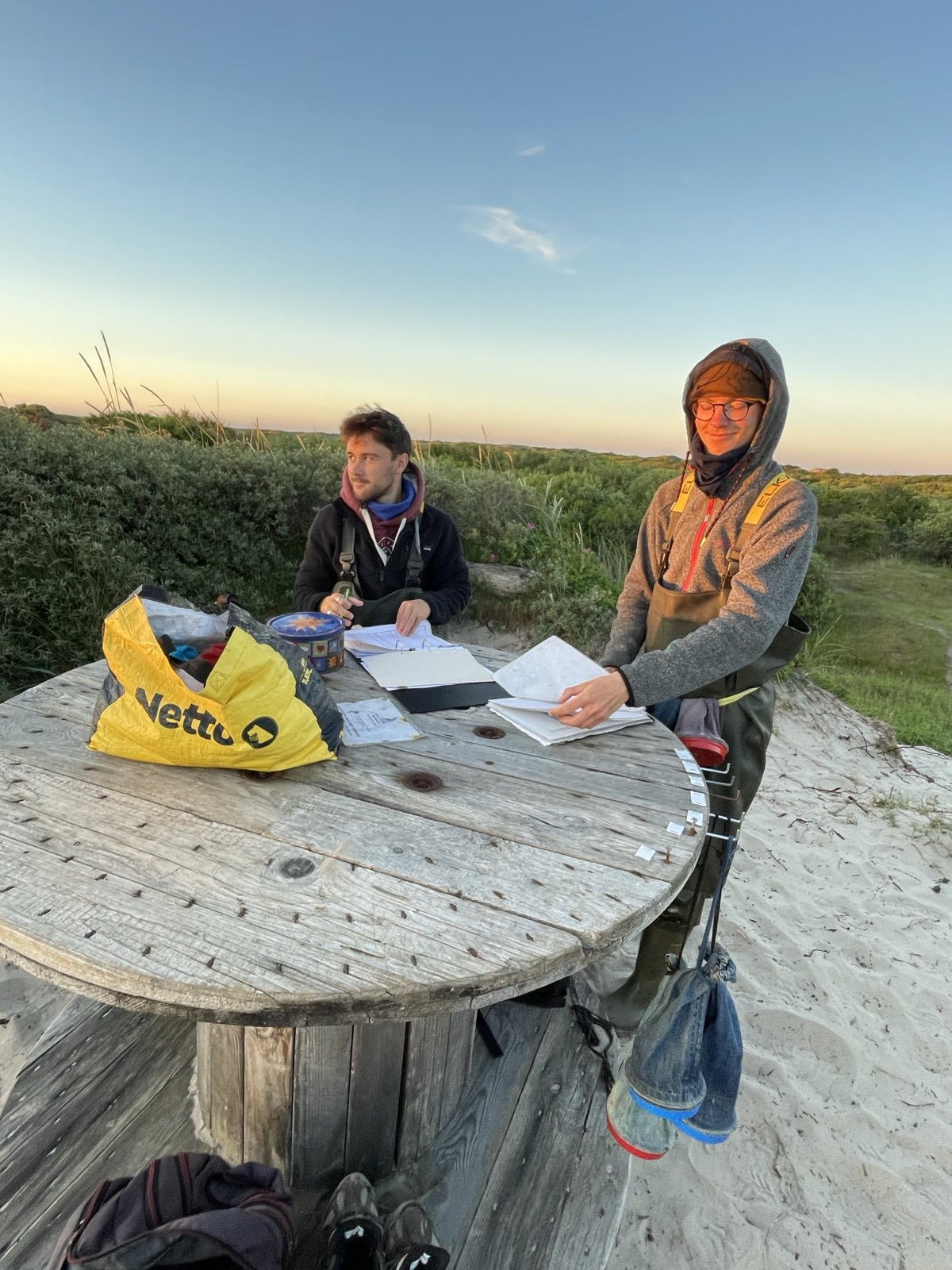
Part one of today's ringing team: Seán and Simon enjoying the sun
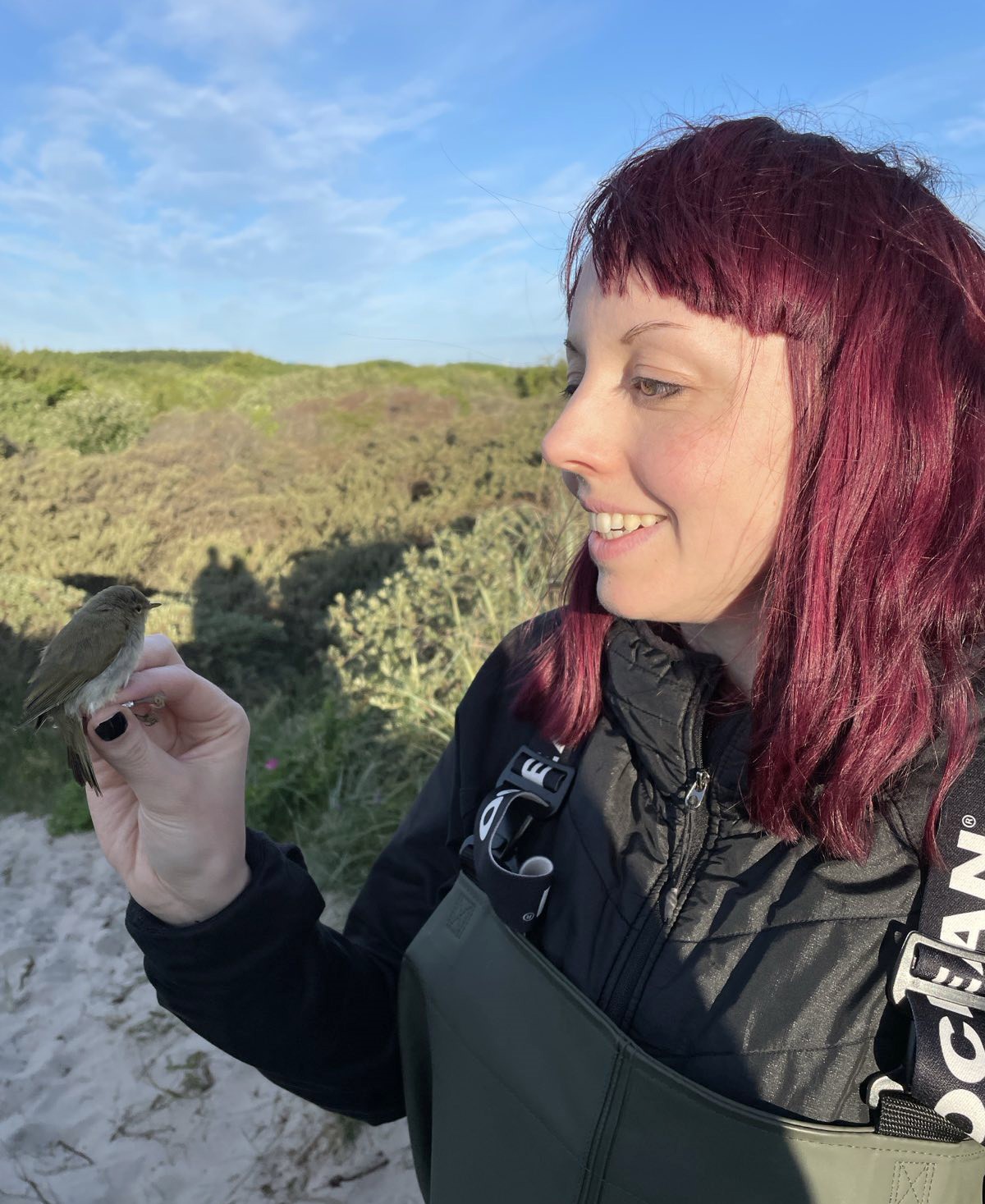 Part two of today's ringing team: Rika with a recaptured Chiffchaff
Part two of today's ringing team: Rika with a recaptured Chiffchaff
One slightly unusual capture today was a very small bird, that on first sight seemed to show the facial features and some coloration features of a Willow Warbler. However, based on the measurements and the indents on the outer webs of the primary feathers (emargination), which were only present on Primaries 3 to 6, we identified the bird as a Chiffchaff.
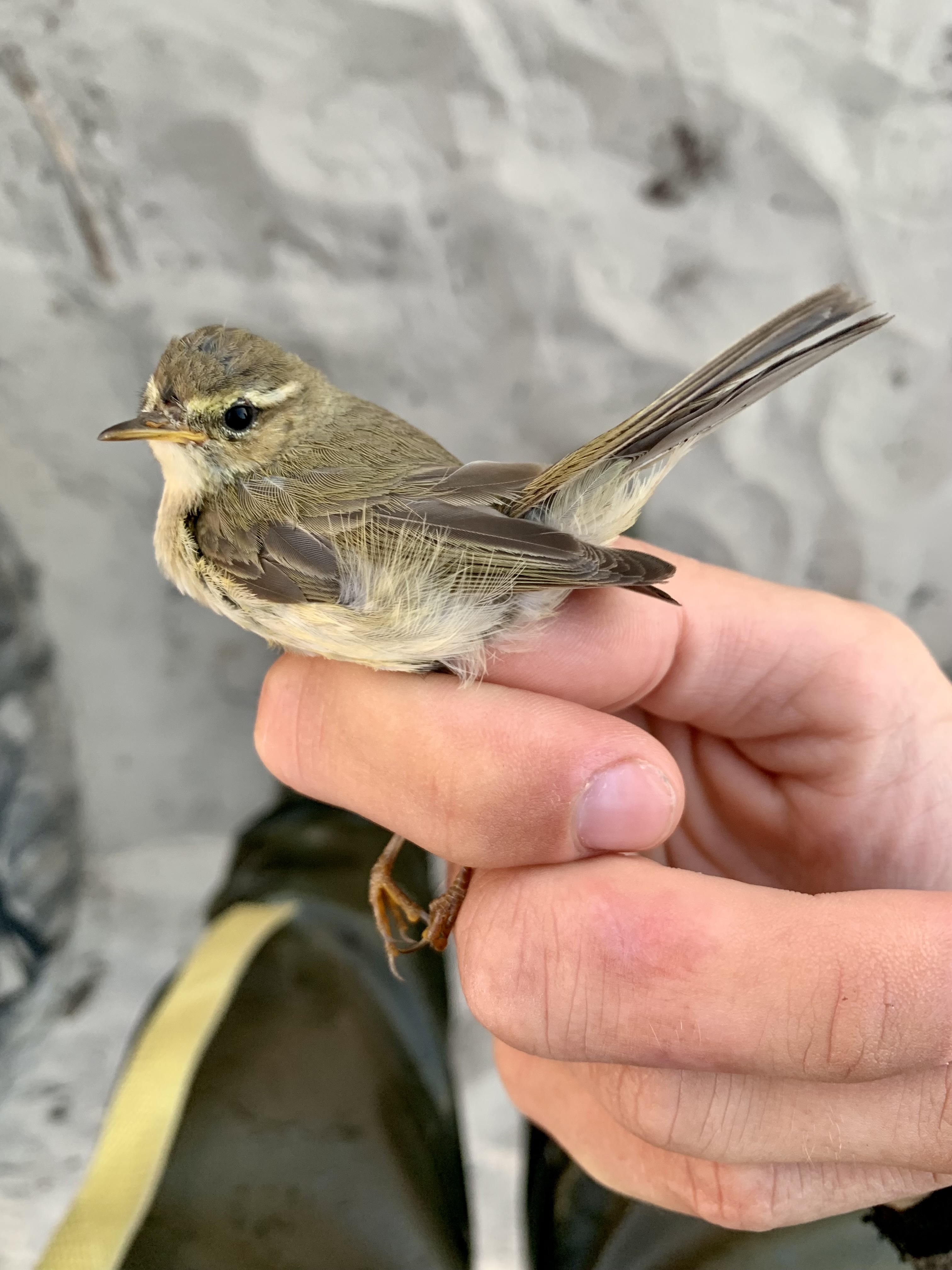
Chiffchaff with interesting supercilium
After catching a handsome male Common Chaffinch, we thought we had gotten the final bird for the day, but got an additional Chiffchaff recapture and a newly caught Reed Warbler thereafter. Unfortunately, the wind started picking up on speed, so we had to close the nets already at 07:45.
Thus, the Reed Warbler became the final bird of this season, and was ringed by Seán. It was time to put up those waders and get some food!
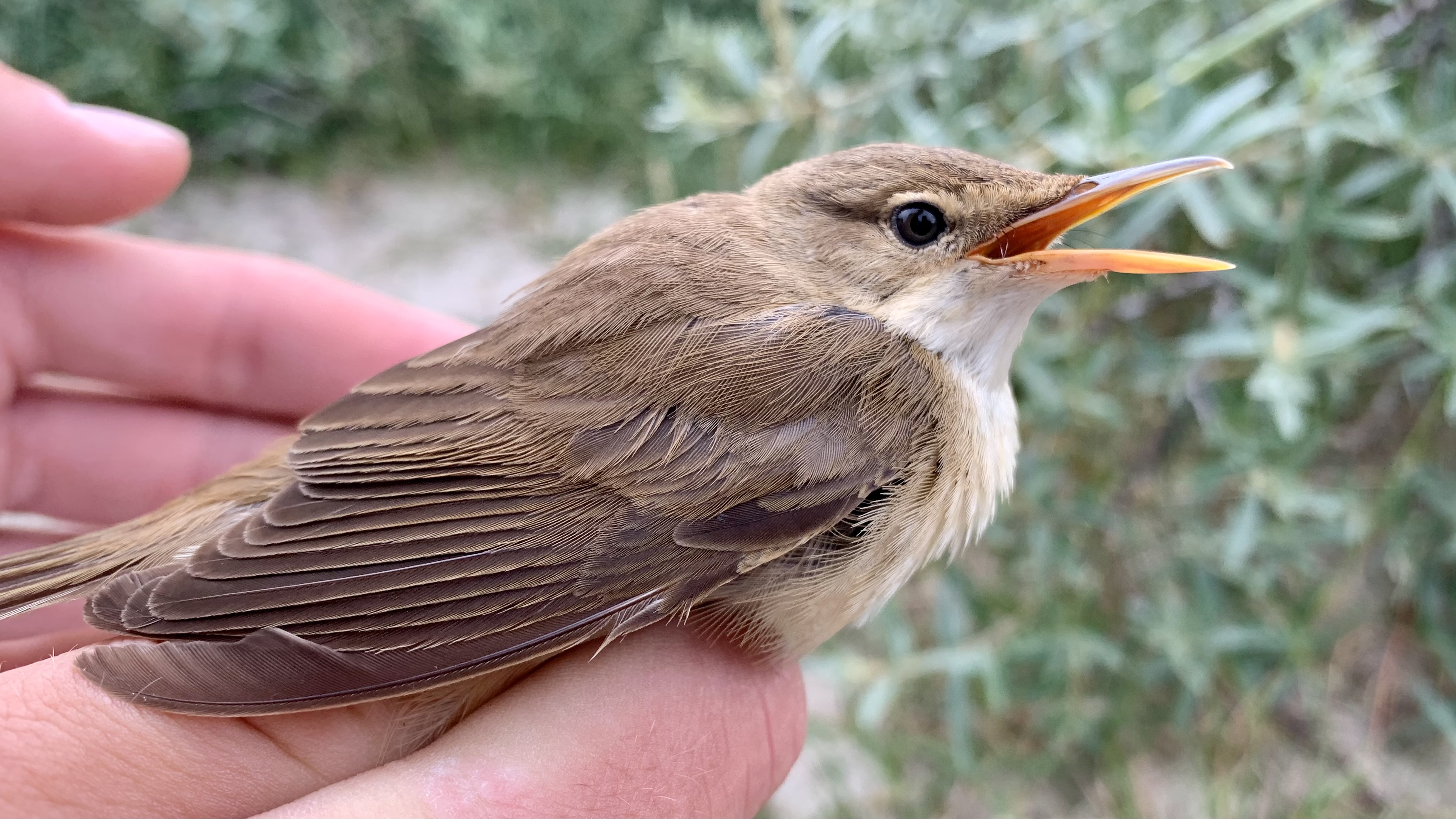
Last bird of the season: Reed Warbler

Return of the waders
The extremely active day and night of the past day (with nightly bird capturing on the beach and guided tours for school classes as you can read on the previous blog post) had left everyone on the team quite exhausted. And despite the effort to catch up on sleep during the day, we decided to take it slow and leave any extraordinary activities for the coming days.
On the last status meeting we had decided to celebrate the finalization of the Spring ringing season by meeting up in the evening, enjoying food and beverages and watch the match of Denmark playing against England at the UEFA European Football Championship together.
We enjoyed a nice meal prepared by Simon K. and then moved to the conference room to watch the match. Luckily, the game ended in a tie!
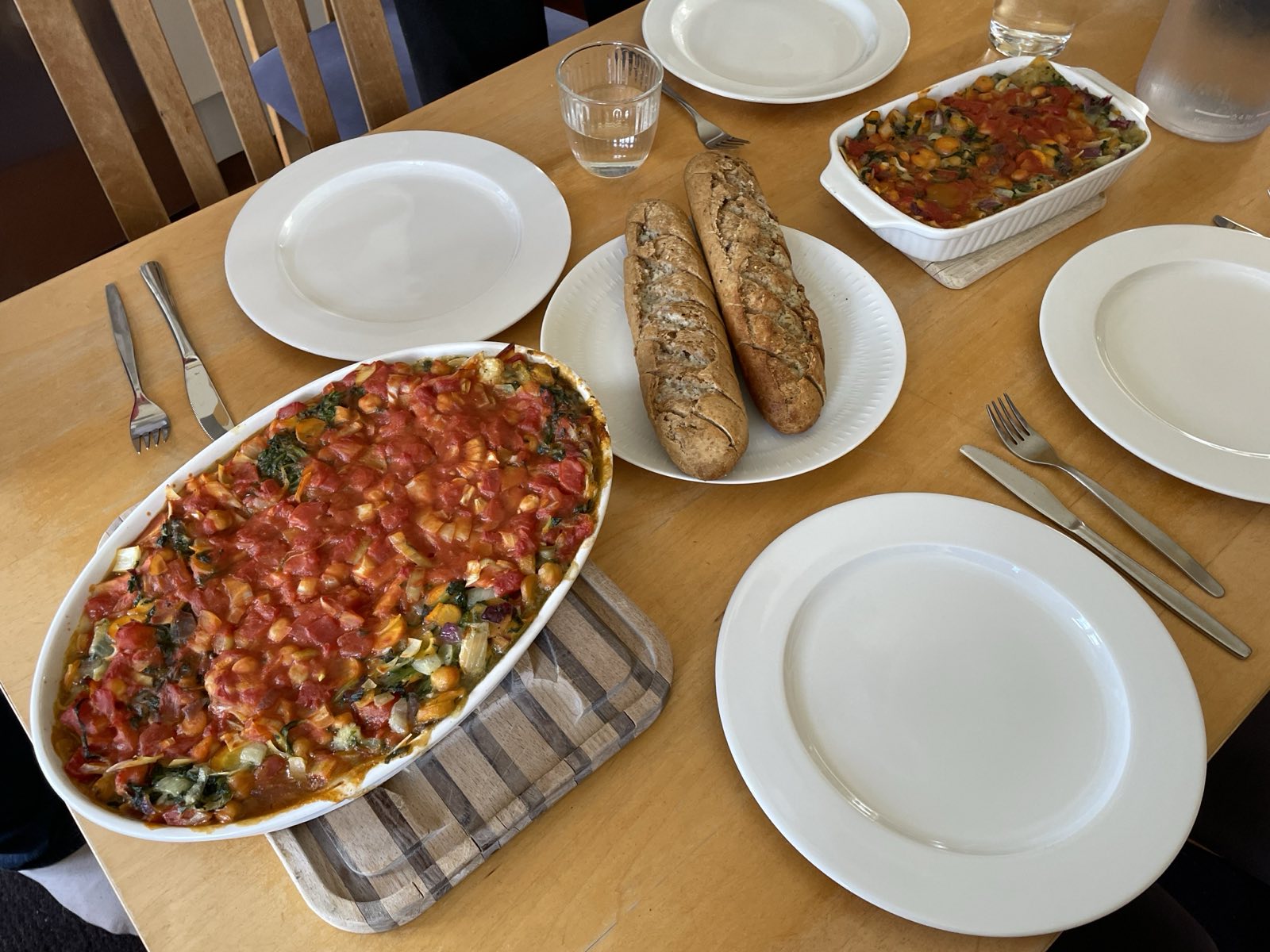
Dinner time
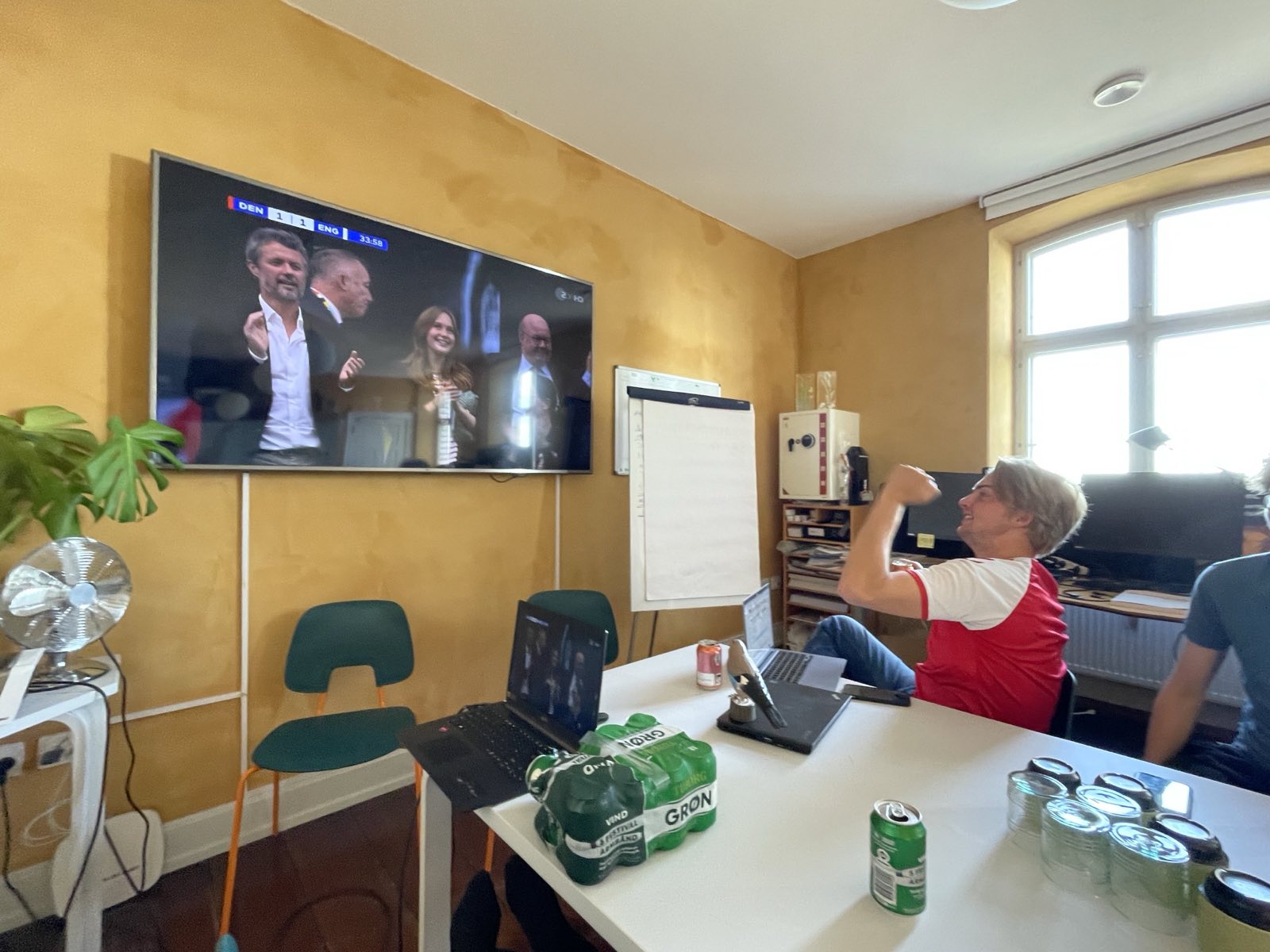
UEFA Champions League - Denmark against England
After the celebrations of the evening and he high number of activities and successes from the recent days, everyone is looking forward to a good and proper night of sleep, without having to leave the bird station at 3:00 in the morning for ringing.
The team is excited about the opportunities of the upcoming days that allow to plan for more flexible and unusual activities when early morning ringing is no longer required.
Ringing (Kabeltromlekrattet):
Reed Warbler (Rørsanger): 2
Icterine Warbler (Gulbug): 1
Common Chaffinch (Bogfinke): 1
Chiffchaff (Gransanger): 1
Total: 5
Today’s observations in Dofbasen from observers in the area.
People: Lucas Corneliussen, Seán Walsh, Magnus Houen Lauritsen, Simon Kiesé, Rika Pydde, Jesper & Anne.
Our passion keeps us awake
Yesterday evening, Simon Kiesé and I fell into the trap of checking data from our morning observations during spring. A task that got us so excited, that we ended up doing it until 11 PM. And since we were awake for so long, we decided not to go to bed, but instead go night catching on the beach, hoping for terns, gulls or waders. We had a cup of black coffee before we headed out. Sean joined os as well.
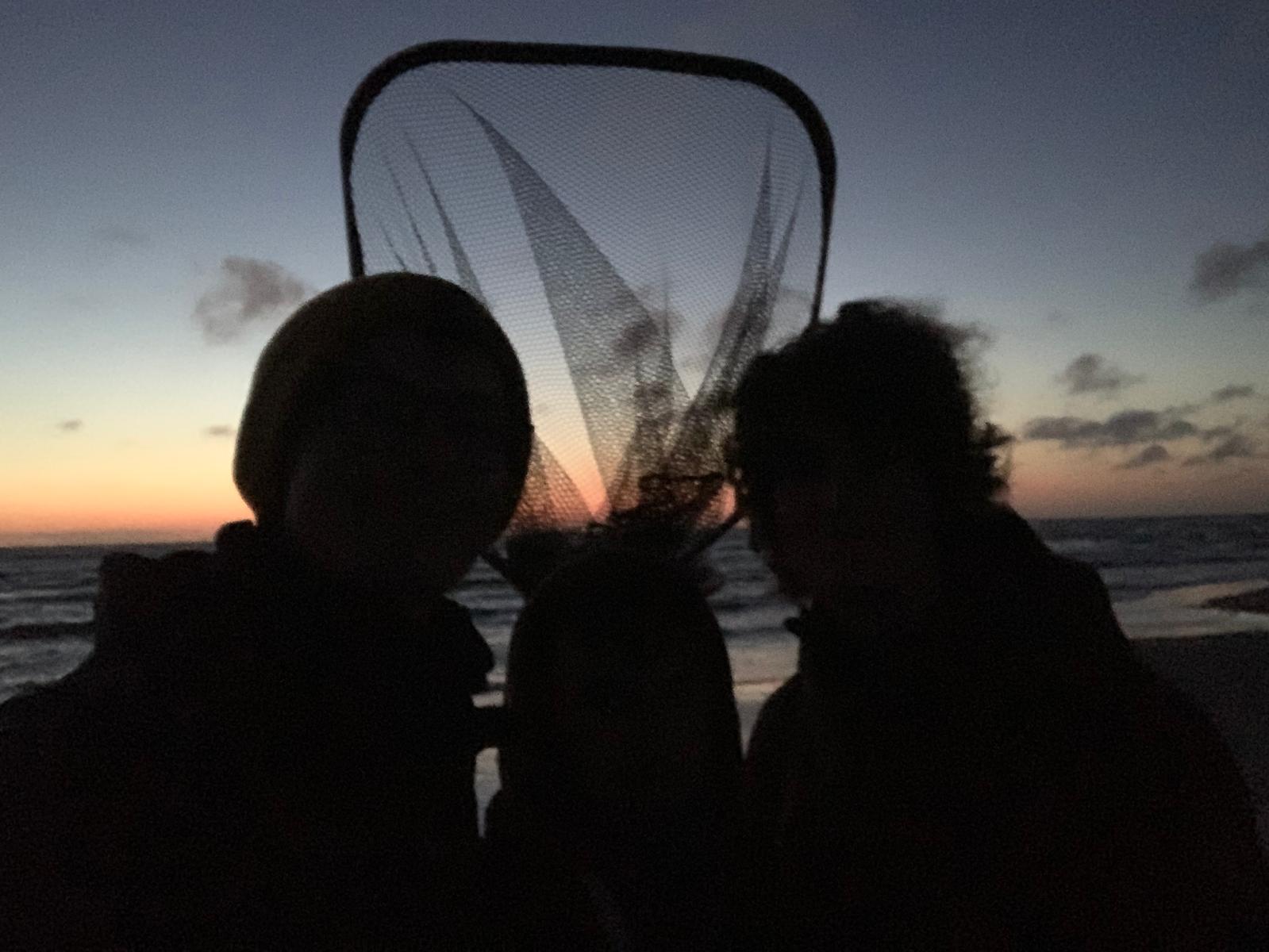
The night team. Photo: Simon Kiesé.
Unfortunately were the gulls and terns super jumpy and shy, while the waders were out of sight. Or except for one wader. Ringed Plover (stor præstekrave). We were lucky to locate a clutch of chicks with their parents. We ringed the chicks first, before we went for the adults.
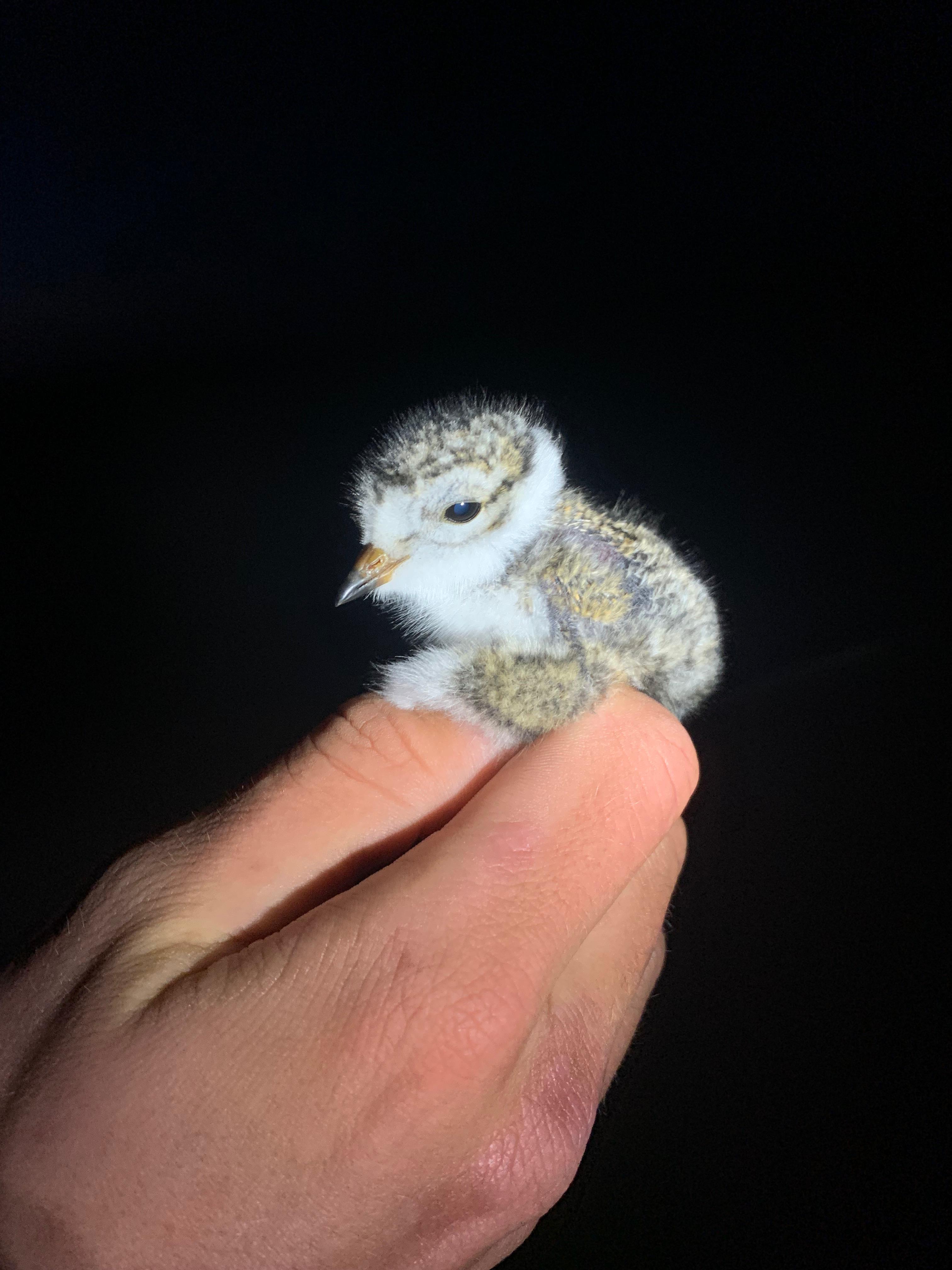
Ringing Ringed Plover chick. Photo: Simon Kiesé.
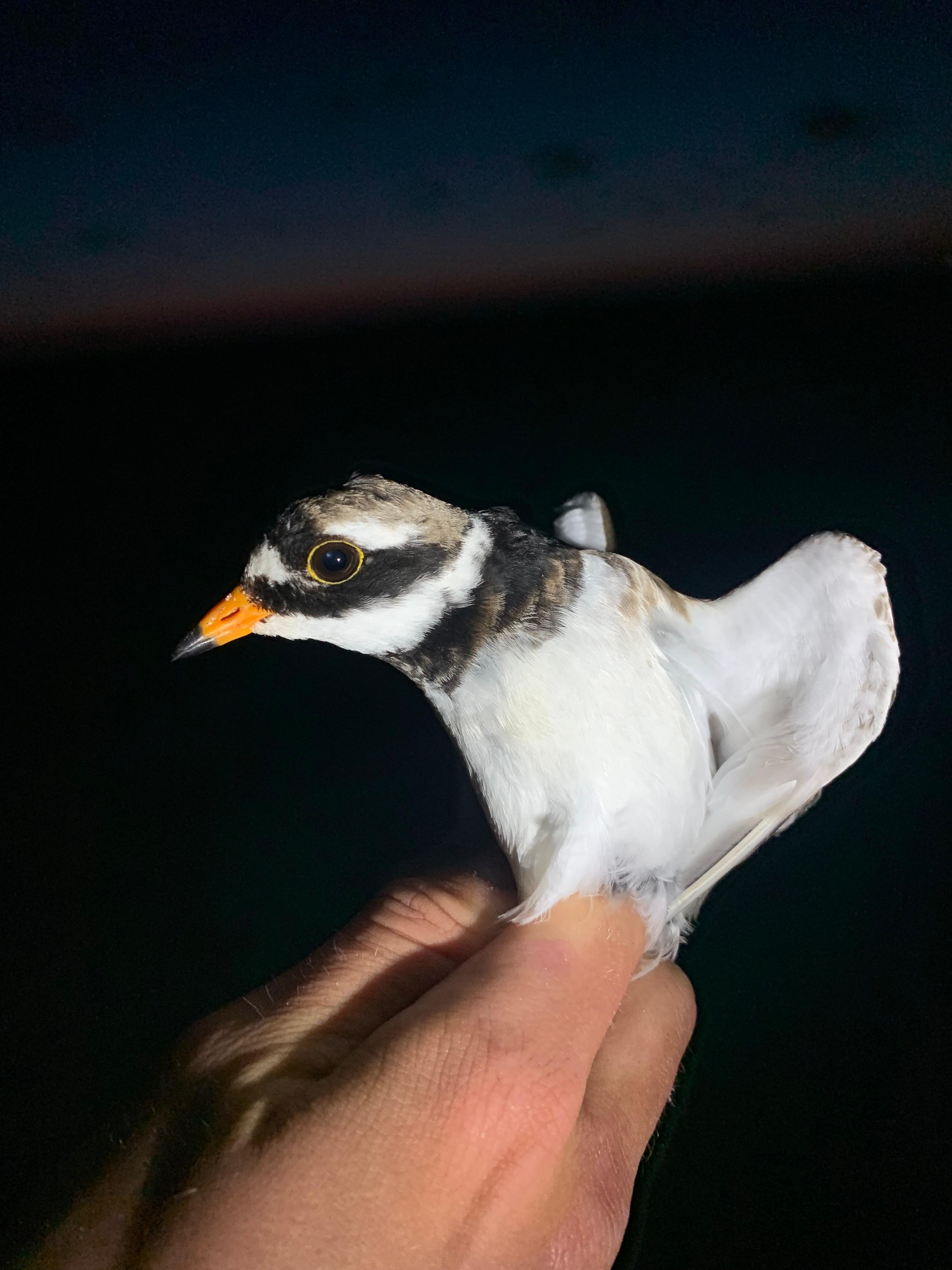
Adult Ringed Plover. Photo: Simon Kiesé.
Seven Ringed Plovers were ringed, before it got brighter, and we decided to head back. We were in a bit of a rush, because we needed a bit of breakfast, since it’s been eight hours since we had dinner.
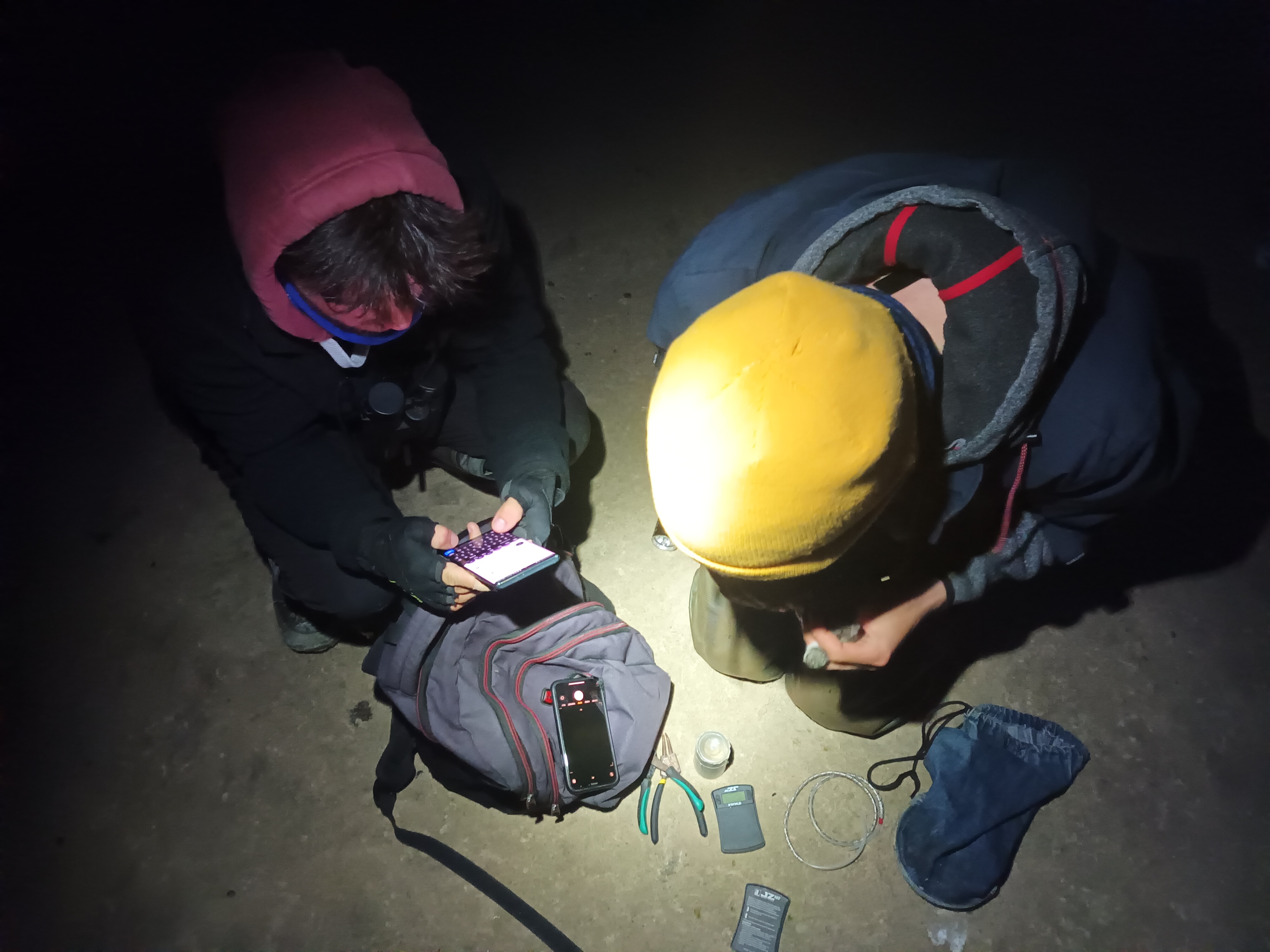
Ringing Ringed Plover chick. Photo: Magnus Houen Lauritsen
I offered to open nets alone, so Sean and Simon could get some breakfast, which we agreed on. It took me about an hour to open the nets - just in time for me to be able to get back to the station, having breakfast for 10 minutes, grab the equipment for counting and head back out to Worlds End 1 together with Lucas, where we did four hours of morning observations. It was rather slow - maybe due to the westerly winds.
It was oddly slow in the ringing as well. Only eight birds were caught, which is around one third compared to recent days.
Both ringers and observators packed their stuff and went back to the station, where two school classes from Frederikshavn had booked a tour. It was super exciting to teach them about ringing and they were super easy as well, since they were calm and wanted to learn about birds. Especially when Simon Kiesé caught a 2, calander year Common Whitethroat (tornsanger). It made us forget about how tired the three of us were at that point.
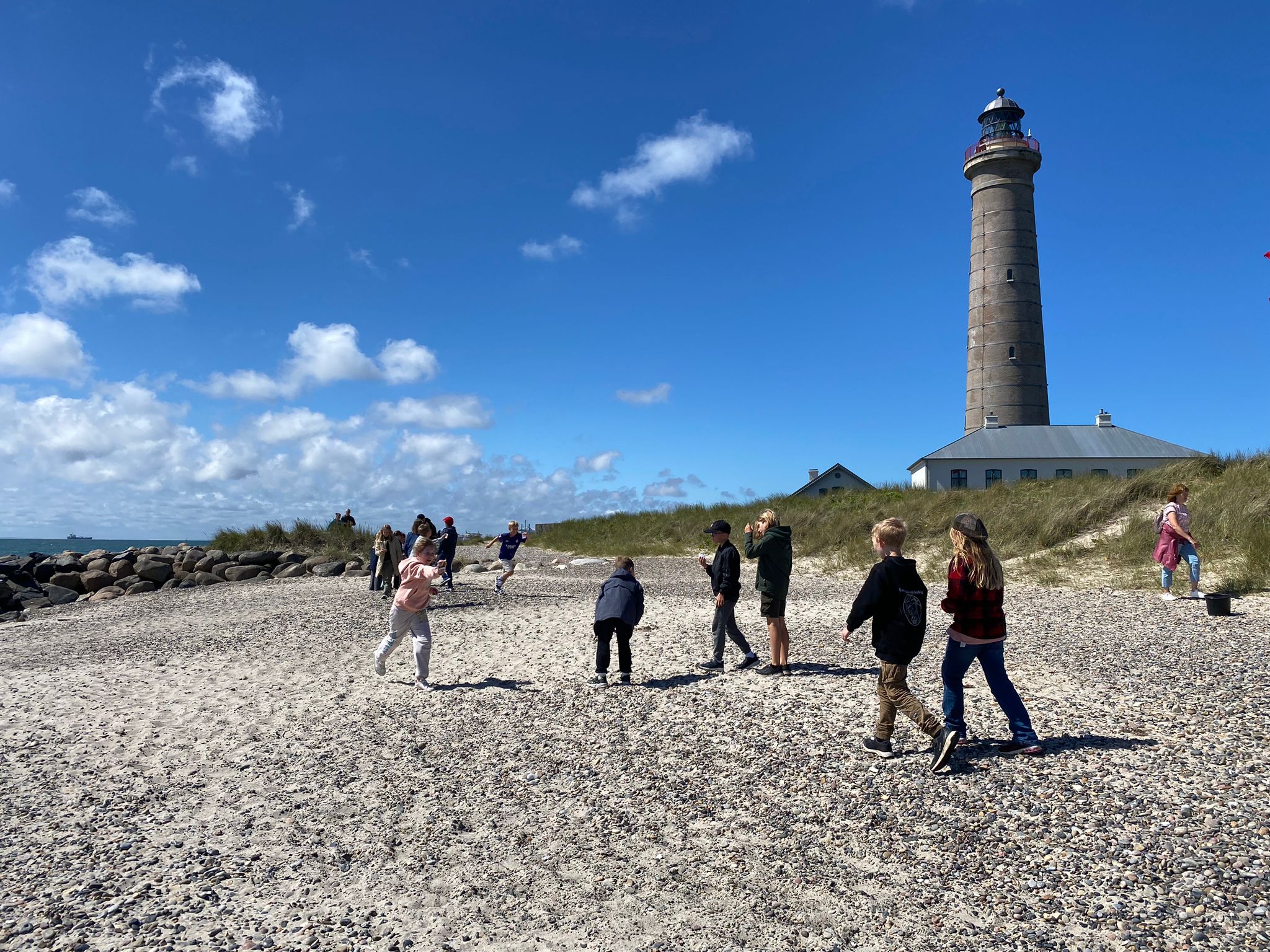
One of the classes at the beach. Photo: SSC
After guiding the two school classes, we finally got some needed rest and sleep, before senior woke us up for the evening meeting approximately 5 or six hours later. And shortly after that, we had dinner, with Rika as the chef.
A bit of football was watched, before we again headed for bed, called it another successful day, and could let the silence fall upon the northernmost bird observatory in Denmark.
/Magpie/Krøllebille/Magnus/MHL.
Ringing (Kabeltromlekrattet):
| Blackcap | Munk | 5 | RI |
| Reed Warbler | Rørsanger | 1 | RI |
| Garden Warbler | Havesanger | 1 | RI |
| Chiffchaff | Gransanger | 1 | RI |
Subtotal: 8
Ringing (Sandormesvinget):
Ringed Plover - Stor præstekrave - 7 RI
Subtotal: 7
Ringing (Den Gamle Fyrhave):
Common Whitethroat - Tornsanger - 1 RI
Subtotal: 1
Total: 16
A link to today's observations from volunteers and local observers.
Sum of observations of raptors on DOFbasen from today.
People: Lucas Corneliussen, Seán Walsh, Magnus Houen Lauritsen, Simon Kiesé, Rika Pydde, Jesper & Anne.
Late Season Arrivals & Isis' Replacement Arrives
With just a few days left of the spring standard ringing protocol, Sean and I left the Grå Fyr at 03:00 and departed for Kabeltrommelen to open the nets for the morning. Conditions were nice in the morning with light wind and partial overcast so we were hoping to have better luck, and unexpectedly, it was much better than anticipated.
A small bit about me: my name is Lucas Corneliussen, I am 20 years old and am from San Francisco, USA. I will be at the station for the next few months and am excited to be here after being at Blåvand Fuglestation for a month in May.
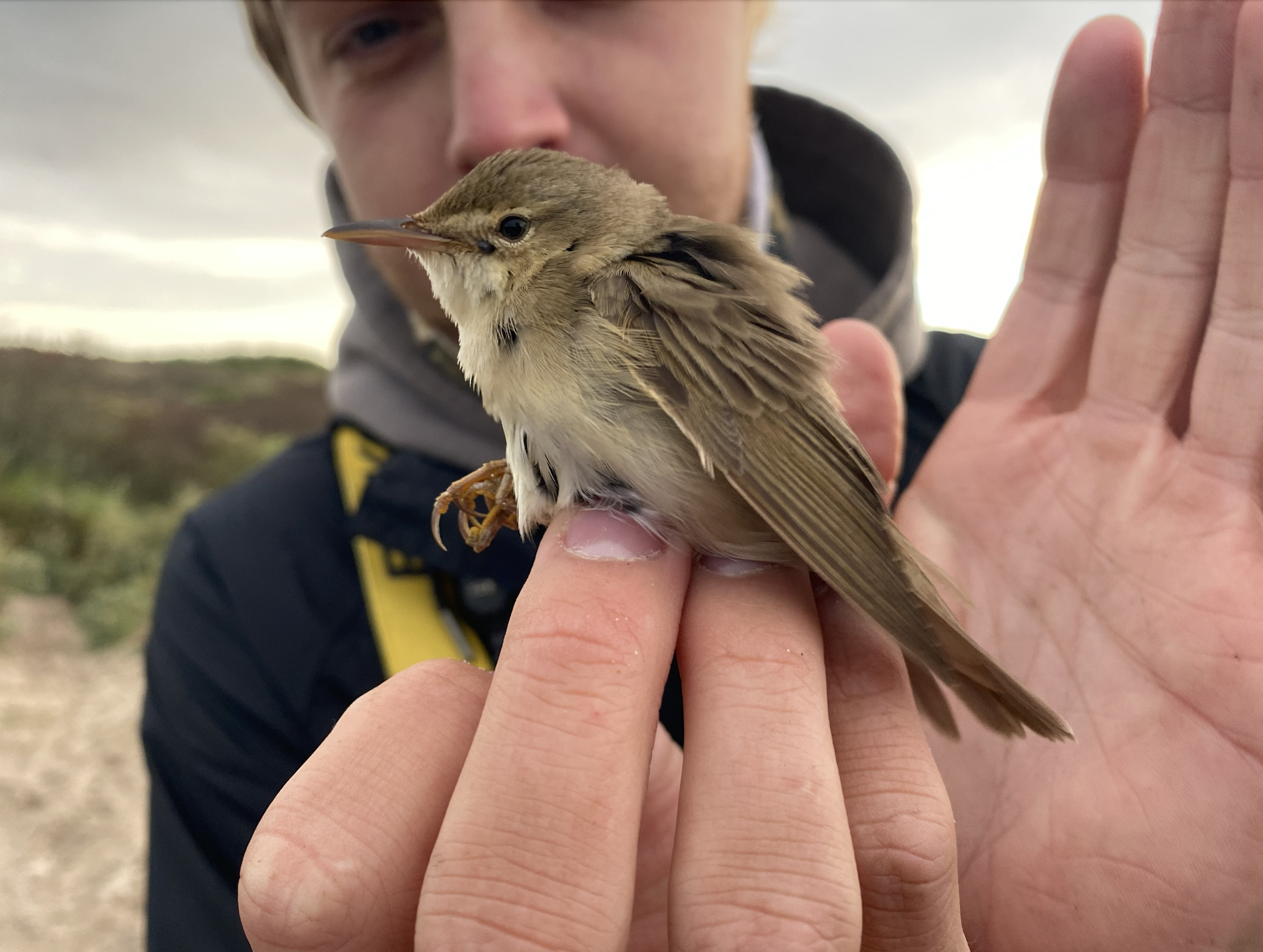
After a very slow ringing season in Blåvand in May, I have been excited to find more than 1 bird in the nets each round. This morning was particularly successful because we had several very nice species in the net including a nice Spotted Flycatcher (Grå Fluesnaper), the first of summer Crested Tit (Topmejse) and a recapture female Brambling (Kvækerfinke); which Simon had caught a few weeks ago. Beyond the more “exciting” catches, the abundance of Blackcap (Munk) and Acrocephalus warblers in the area continue to amaze me. It seems almost never ending. We had a surprisingly nice morning for numbers this time of year, surpassing 35 individuals and decided to keep the nets open an extra hour. Unfortunately, the productivity slowed and we closed the nets at 09:45, no more than 10 minutes before a stray thunderstorm rolled through!
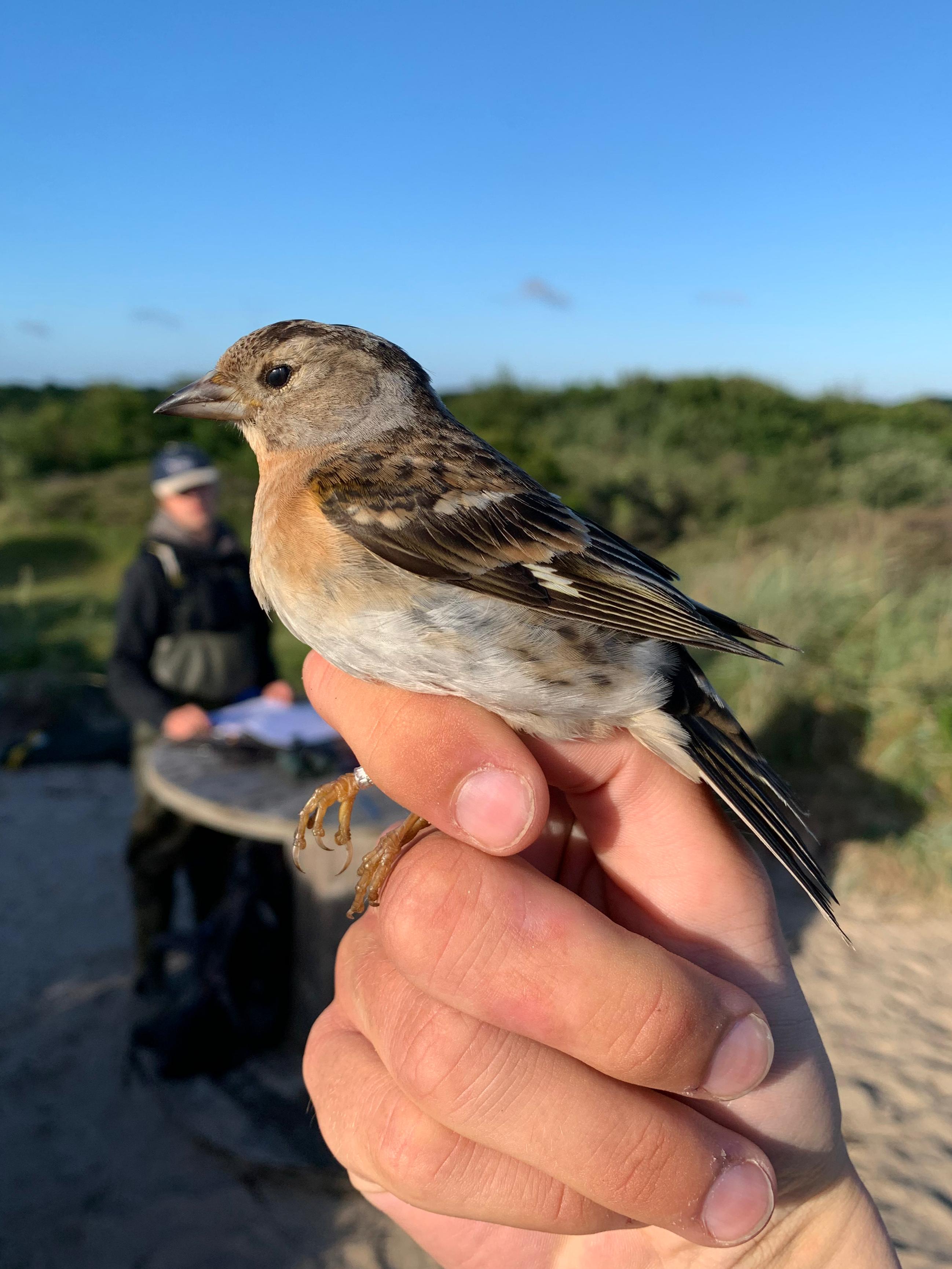
The team rendezvoused at the station for some much needed rest during the middle of the day before introducing Rika to the team in the afternoon! She joins us from Copenhagen for the next few days.
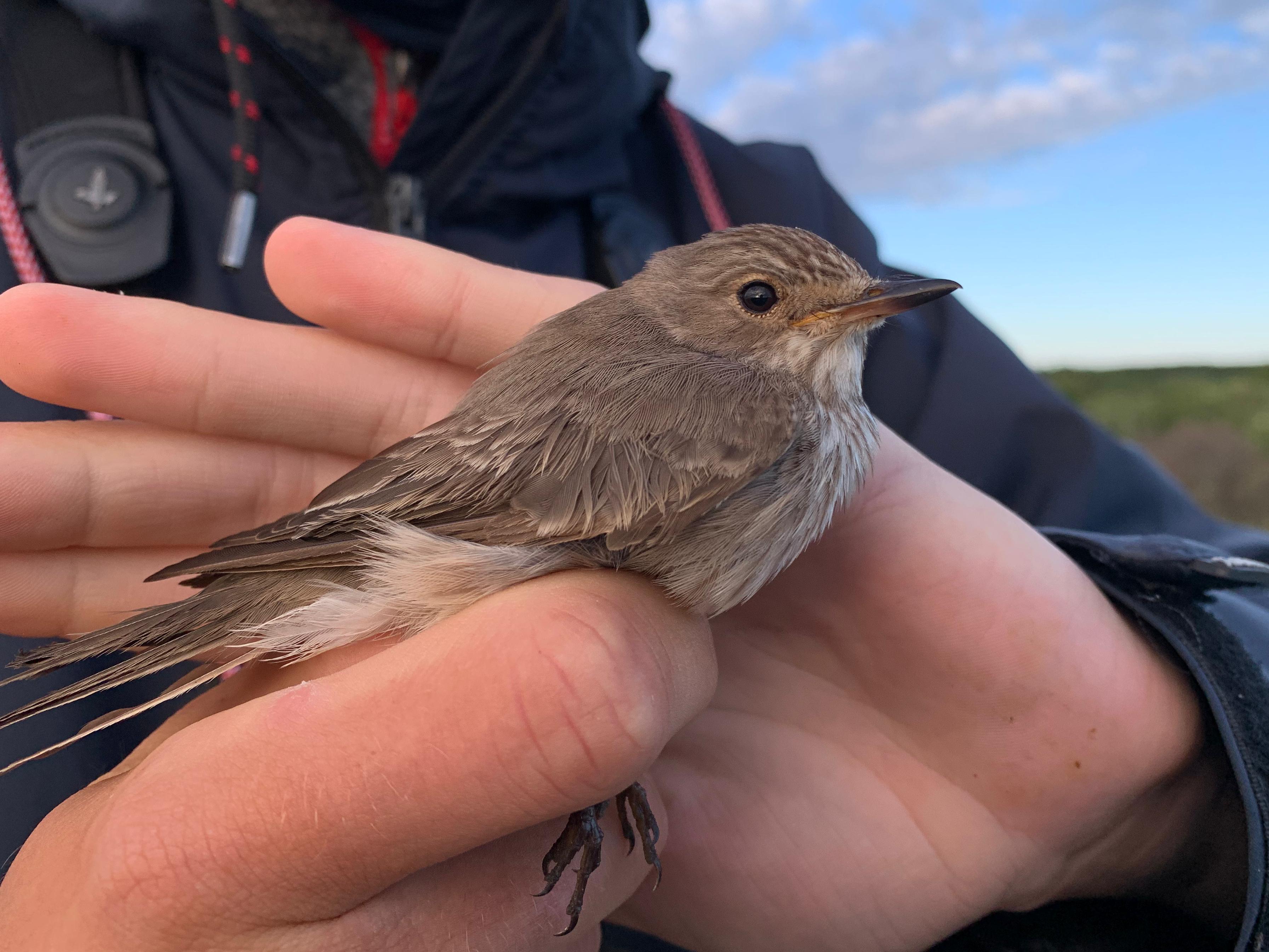
After dinner, Simon and Rika headed to beach and recaught 2 of the Common Ringed Plover (Stor Præstekraver) chicks. They have gained 19 grams in 11 days! - Wow. They are so cute and we are really enjoying being able to watch them as they grow.
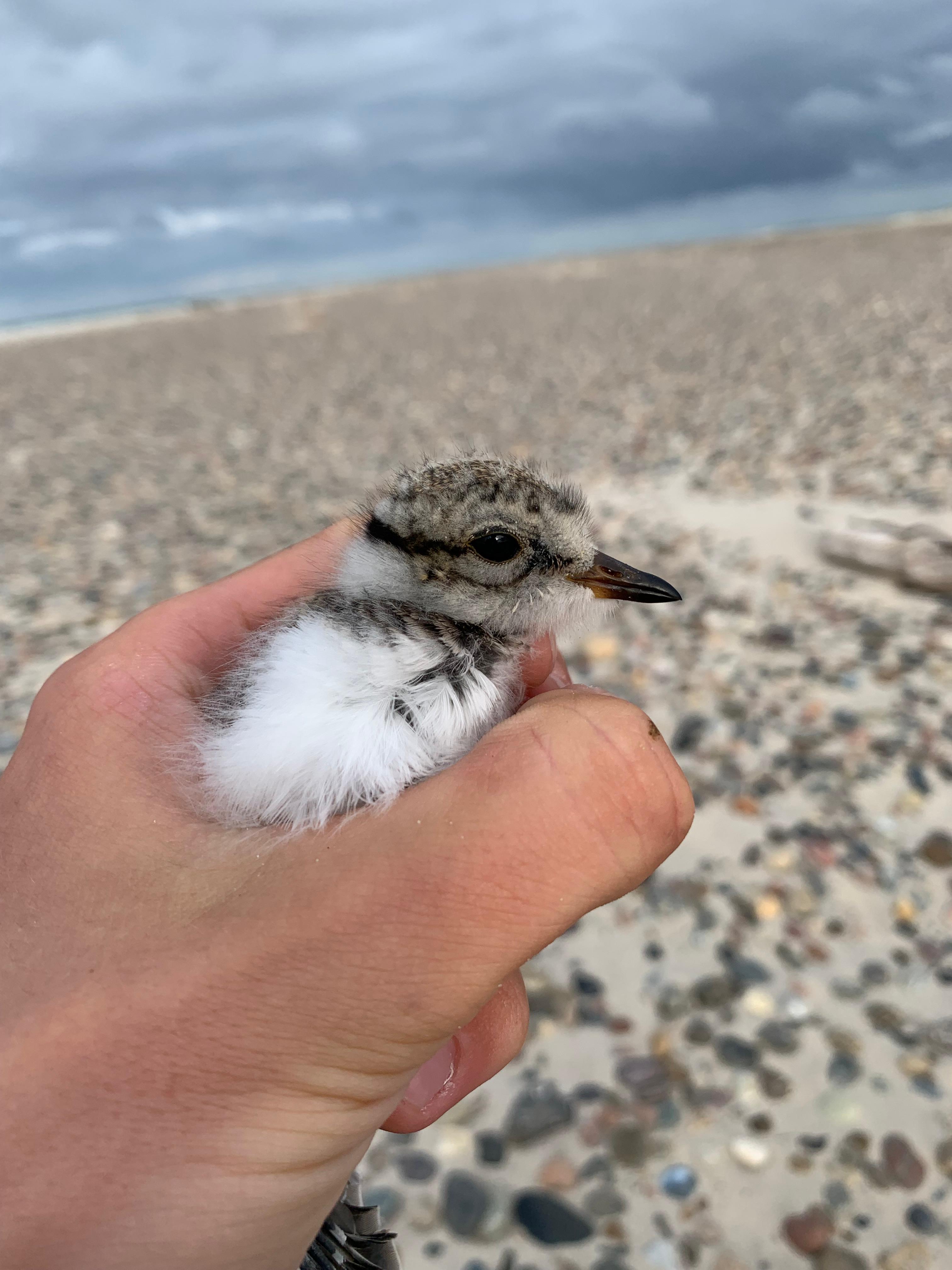
And so, another day passes. Who knows what tomorrow will bring as the strong westerly winds pick up!
Ringing (Skarvsøen):
Lesser Redpoll (Lille Gråsisken): 1
Crested Tit (Topmejse): 1
Reed Warbler (Rørsanger): 2
Marsh Warbler (Kærsanger): 3
Garden Warbler (Havesanger): 1
Common Whitethroat (Tornsanger): 1
Lesser Whitethroat (Gærdesanger): 4
Spotted Flycatcher (Grå Fluesnapper): 1
Common Chaffinch (Bogfinke): 1
Chiffchaff (Gransanger): 3
Blackcap (Munk): 14
Total: 32
Today’s observations in Dofbasen from observers in the area.
Sum of the raptors in the area based on observations typed into Dofbasen the same day.
People: Lucas Corneliussen, Seán Walsh, Magnus Houen Lauritsen and Simon Kiesé, Jesper & Anne, Rika Pydde
Munks Gone North
These days are slow as the season is reaching its close. Nonetheless, Simon, Lucas, and I were abruptly awoken from our slumber by our alarms at 02.15. This morning felt particularly rough, since we had stayed up watching the Euro Football match last night. But, not long after opening the nets at Kabeltromlen, were we rewarded by one of Skagen’s specialties: a gorgeous sunrise.
Kabeltromlen Sunrise.
The sun reached out from the heavens and gave us a big warm hug, and suddenly we remembered where we were: Skagen. Truly a place like no other. Though there were a few birds, the species were not particularly interesting (nor worth discussing further in this blog, but that’s not to say that we don’t appreciate all birds!). The biggest highlight would be that we had our very first hatchling Lesser Whitethroat (Gærdesanger) and it was sooooo cute! It still had big cheeks and dark little eyes, and so much fuzz on its belly! As you can probably tell, I was a fan.
Unfortunately we did not take ANY pictures of the cute little one, we must not have been in the best mindstate. (How could this happen!) We will not make such a careless mistake again… It could be that we were distracted by the Honey Buzzards (Hvepsevåge) flying over us, but that is no excuse.
Instead, the only compensation I have to offer is this beautiful male Eurasian Blackcap (Munk - Han) in the golden sunshine:
Eurasian Blackcap (Munk). Isn’t he dapper?
Anyway, while all this was happening Seán, who had failed to sleep through the night, was running side-quests. As it rained, he worked on some raptor summaries, then, when the rain cleared, he headed out to the dunes for some birdwatching. Not long after, he met us out at Kabeltromlen as we arrived to open the nets. God morgen! He then went on to count some hours. Migration was slow, but he did see a European Shag (Topskarv)!
Magnus was also counting, but his birds did not have wings, instead they wore a nice coat of fluffy wool… zzzzz…
In the afternoon, Simon, Lucas, and Magnus biked to Flagbakken to attempt to see if the Eurasian Griffon Vultures (Gåsegrib) from Germany had made their way up to Skagen. They did not see the vultures, but still had fun birdwatching:
Simon, Magnus, and Lucas at Flagbakken.
I, on the other hand, faced a massive battle: going downtown during the cumulative load of two cruise ships docking in our harbour. There were people EVERYWHERE. Mette told us that today we’d had the record number of guests at the lighthouse for the season! You may be wondering why I decided to go into town on a day like today, well… I needed to buy a seagull onesie for my niece. It was imperative I go today since over the weekend the shops were closed, and tomorrow I will be leaving (I will explain more about this later).
When I got back to the station from town, I had an email in my inbox that one of the birds I ringed earlier in May had been caught in Norway! That is cool! This young male Eurasian Blackcap (Munk - Han) flew from Skagen, Denmark to Bygland, Norway in just 3 days! That is 197,6 km flown in across the ocean, what a powerful little bird.
I am very proud of my little Blackcap (Munk).
Anyway! I will be going home for a couple days tomorrow so that I can visit my niece (and renew my passport…), but don’t worry, I will be back very soon to finish up the season.
Vi ses!
Ringing (Kabeltromlekrattet)
Reed Warbler (Rørsanger) - 1
Eurasian Blackcap (Munk) - 11
Lesser Whitethroat (Gærdesanger) - 6
Marsh Warbler (Kærsanger) - 1
Willow Warbler (Løvsanger) - 1
Tree Pipit (Skovpiber) - 1
Common Whitethroat (Tornsanger) - 1
Common Chiffchaff (Gransanger) - 3
Total: 25
Today’s observations in Dofbasen from observers in the area.
Sum of the raptors in the area based on observations typed into Dofbasen the same day.
People: Isis Khalil, Seán Walsh, Lucas Corneliussen, Magnus Houen Lauritsen and Simon Kiesé, Our New Guests
Make Lucas Batman (or introducing the new volunteer to ringing at Kabeltromlen)
Finally, the standardized counting period is over, but Magnus was keen enough to go out for an additional count. There was not much migration – this proofes, why it makes sense to end the standardized count in summer. Otherwise there are still birds you don’t want to miss. One of them was an Arctic Skua (Almindelig Kjove) and Magnus also found a Black Tern (Sortterne).
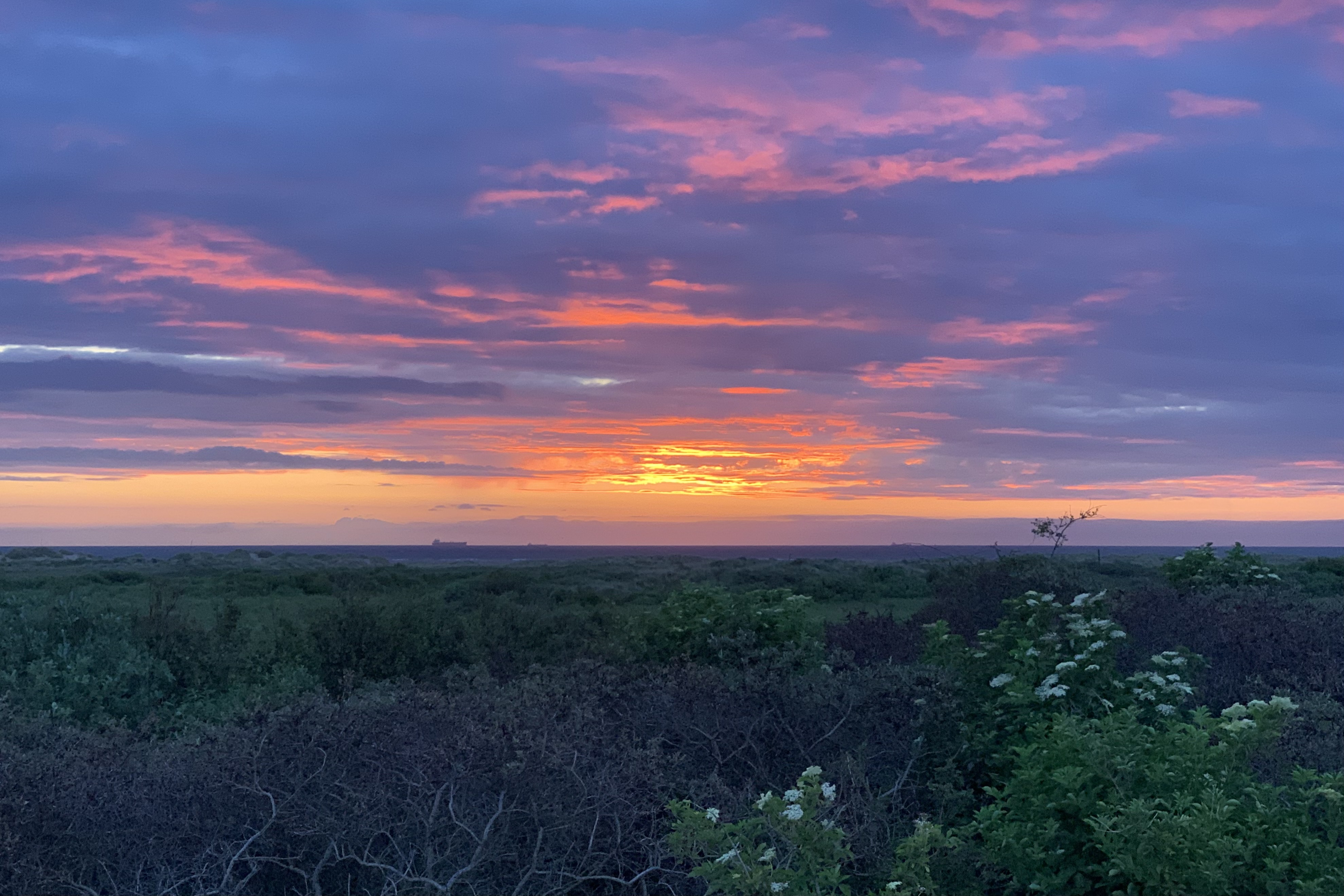 Another beautiful morning at Grenen.
Another beautiful morning at Grenen.
It was the first morning for Lucas to join us ringing at Kabeltromlen. It was an average late June day without many surprises but we appreciated the Acrocephalus Warblers in anyway. Our goal now is to make Lucas (who arrived yesterday) Batman. That means, we have to teach him everything we know about out tasks and the station, that he can share it with the summer team, because everyone except him leavs the station on the first of July. Lucas is doing really good, so he will easily manage that!
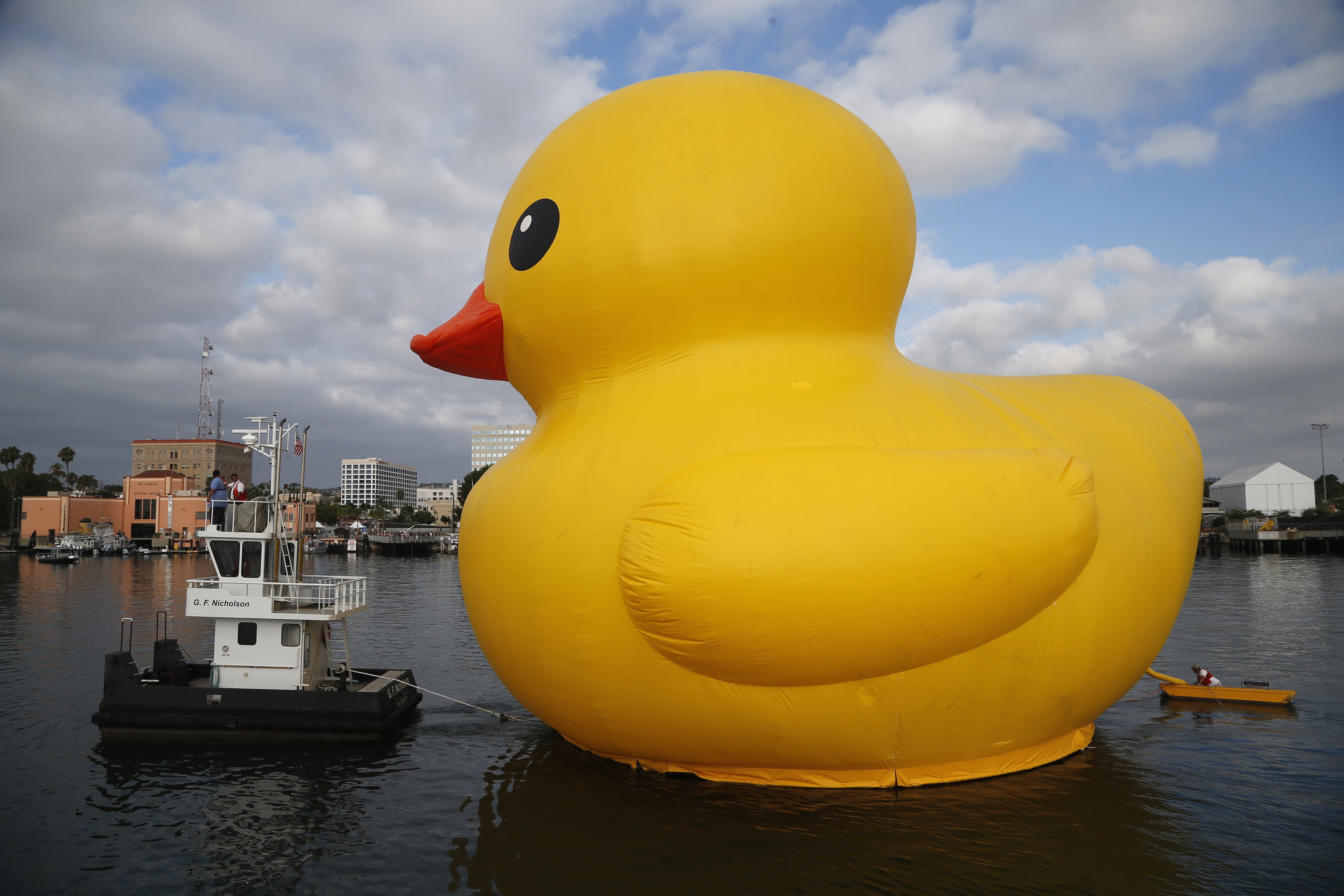
My highlight might have been a family of young Chiffchaffs (Gransanger), we had ringed a few days ago and which made its way into our nets again. They were all in good condition! When a rain shower came, we closed and headed back to the station.
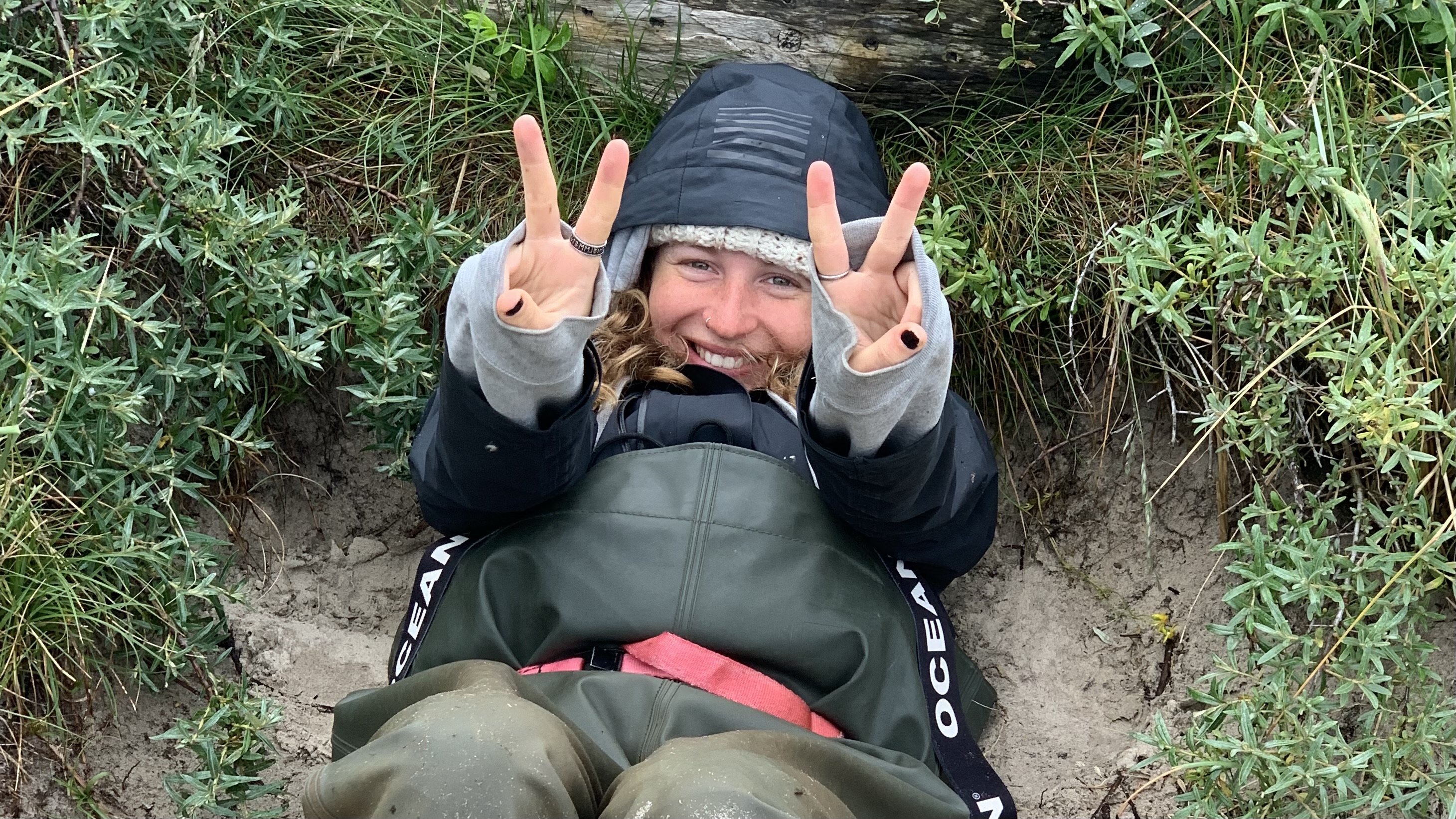 Isis is enjoying the ringing.
Isis is enjoying the ringing.
While we keep the station running, Simon Sr. is on vacation right now. He really earned some calm and fun days after working like twenty hours per day for the entire season without weekends or days off. It seems like his trip is fun, since they got a look on the Pygmy Cormorant (Dværgskarv) in southern Denmark. Funnily they met Søren – our guest from the past two weeks – there.
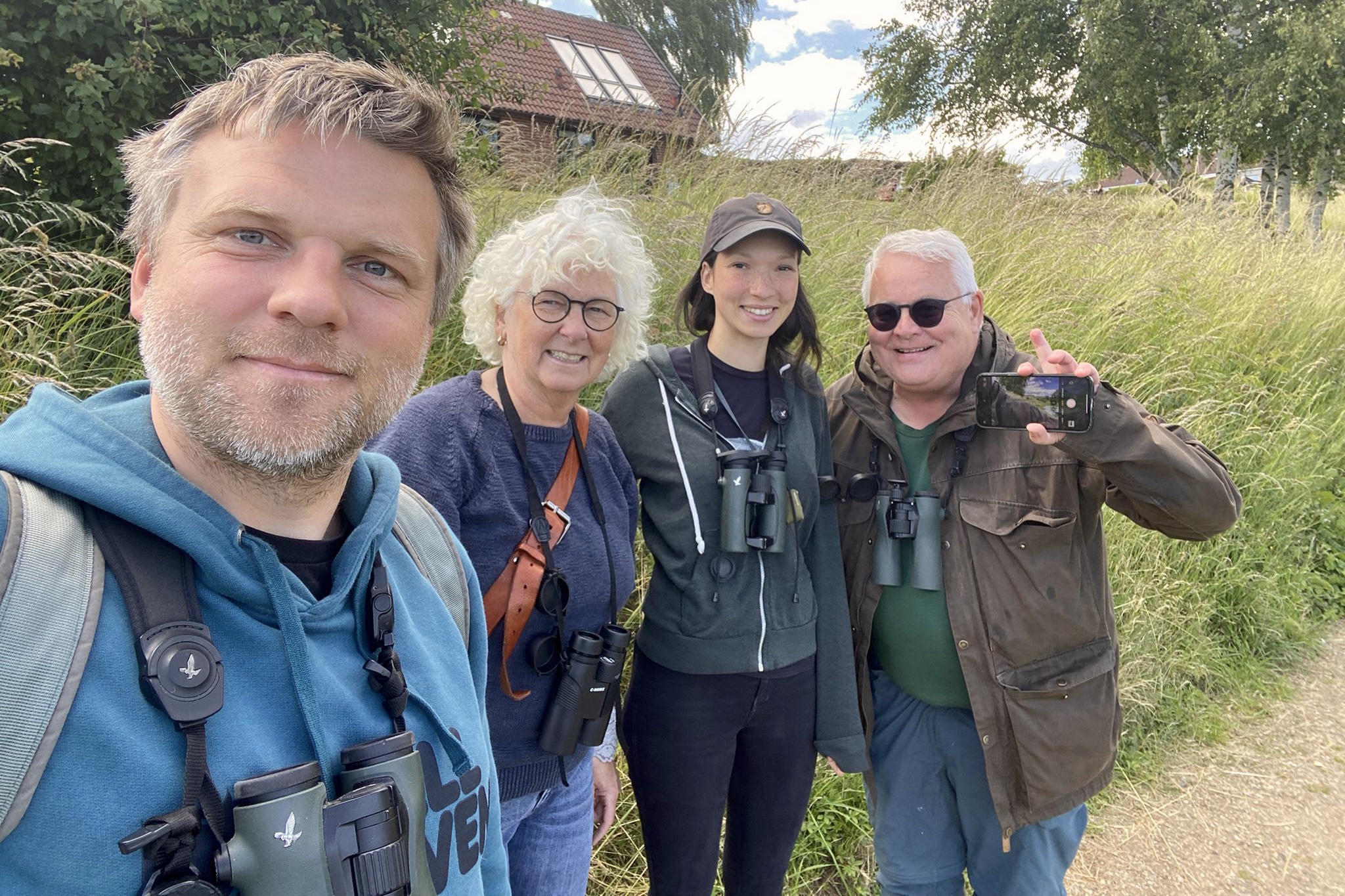 Meeting old friends.
Meeting old friends.
In the afternoon our new guests arrived and we did office work as soon as we finished our nap.
Ringing (Kabeltromlekrattet):
| Lesser Whitethroat |
Gærdesanger | 1 | RI | |||||||||||||
| Marsh Warbler | Kærsanger | 2 | RI | |||||||||||||
| Blackcap | Munk | 8 | RI | |||||||||||||
| Reed Warbler | Rørsanger | 3 | RI | |||||||||||||
| Garden Warbler | Havesanger | 1 | RI | |||||||||||||
| Chiffchaff | Gransanger | 1 | RI |
Total: 16
A link to today's observations from volunteers and local observers.
Sum of observations of raptors on DOFbasen from today.
People: Isis Khalil, Seán Walsh, Lucas Corneliussen, Magnus Houen Lauritsen and Simon Kiesé.
Simon's first Swallow
Today was probably the earliest start we would ever have to endure, as the sunrise has finally reached its earliest for the summer (04:16). And since we had to go to the CES site at Skarvsøen, that meant leaving the station at 02:45 to open nets from 03:15 to be completely open at 03:45. So that's a very long, early morning. And Simon was convinced it wouldn't be worth it. Opening didn't take so long as usual, just that the nets were a bit harder to open because we don't open them so often.
The first round yielded the usual birds; an early morning Solsort (Blackbird) and Rørsanger (Reed Warbler). What surprised Simon the most was the number of birds in this and in the subsequent rounds. Because of the wind, he had expected a day far worse for numbers, but it turned out to be an average of 5 birds per round right until the end. The big highlight in the first round was a Landsvale (Barn Swallow), a species we rarely catch but often see in their dozens. Simon got to ring this bird, which was his first, and he hadn't seen this bird in hand for a few years. 
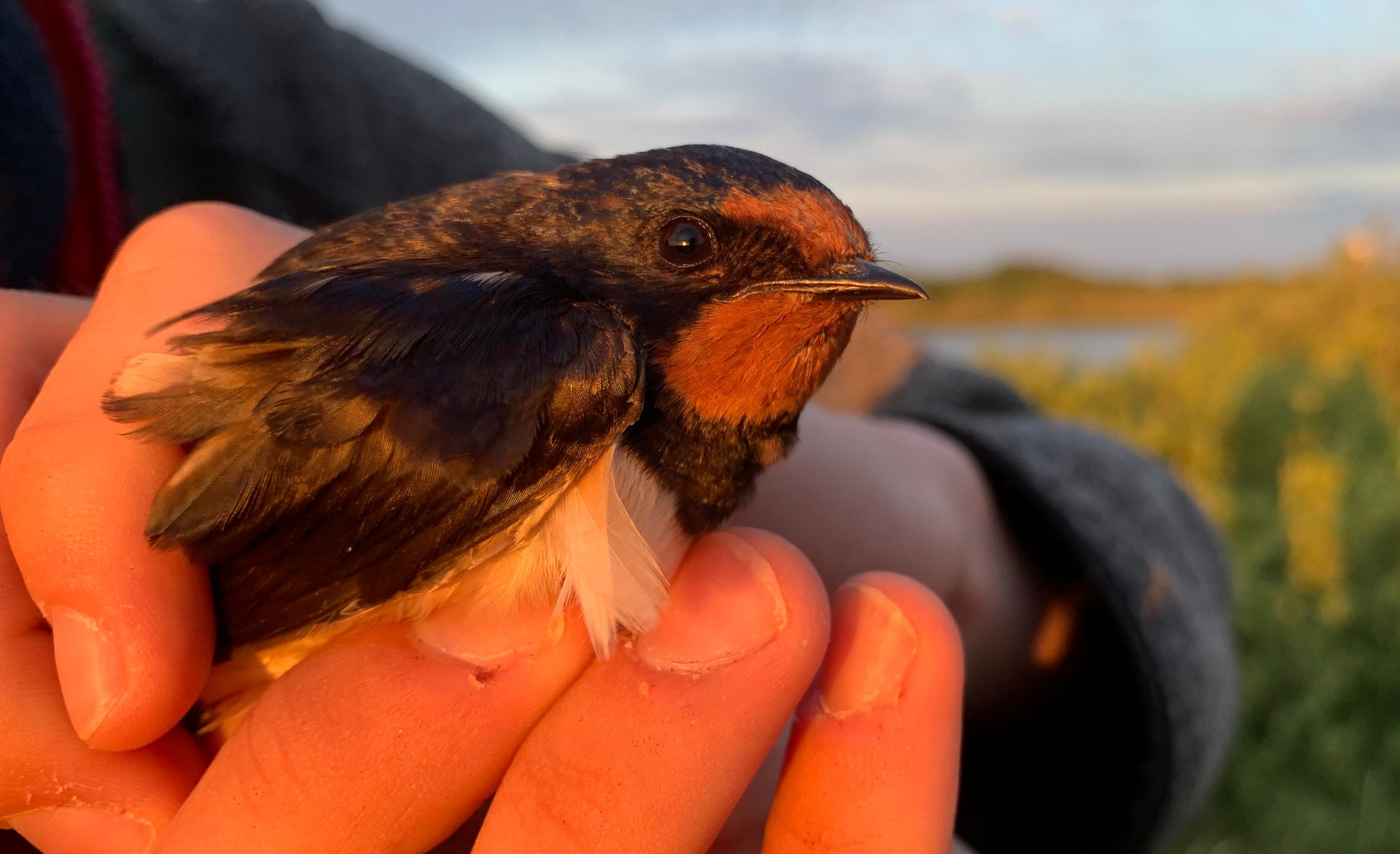
While birding in the morning while I was walking a net round, Simon found a (probable) Sandterne (Gull-billed Tern), which are very rare up here. The nearest breeding colony is on the north-west coast of Germany. Later, while in between rounds, he was preparing a ringing bag when he looked up and found a Rovterne (Caspian Tern) flying along the lake! That was two strokes of luck that morning, all while I was busy doing something else.
Isis and Magnus did the morning count today; the very last one of the season. As dramatic as that sounds, the actual observations were underwhelming, with the highlights being an Almindelig Kjove (Arctic Skua). Later, they went to Grenen beach to try to see our rare terns, but to no joy.
After ringing and counting Isis, Simon and I made an unsuccesful attempt to ring Stor Præsterkrave chicks at Nordstrand, and later (while I was asleep) welcomed newcomer Lucas Corneliussen to the volunteer team.
Ringing (Skarvsøen):
Barn Swallow (Landsvale): 1
Reed Warbler (Rørsanger): 15
Garden Warbler (Havesanger): 1
Common Whitethroat (Tornsanger): 2
Chiffchaff (Gransanger): 1
Total: 20
A link to today's observations from volunteers and local observers.
Sum of observations of raptors on DOFbasen from today.
Seán Walsh, Isis Khalil, Magnus Houen Lauritsen and Simon Kiesé.
Fulmarch
Today turned out to be a great Fulmar day.
I woke up at 03.25, ready for having a sleep in. But since I was the one in charge of counting, I had to grab the bull by its horns and make it out of bed. Since we now have ice coffee in the fridge, that’s the boost needed in the morning. I stood in the kitchen and enjoyed nature waking up outside our kitchen windows, only armed with flowered underwear and a glass of ice coffee.
I made myself a sandwich I could bring for the count, before I headed out. I was at Worlds End 1 at sunrise, and quickly checked for migration fulmars. There were some, but not so many, that we would end above 300 during the day. After a quick check of the bushes with the scopes, I focused on the sea again, which I did for all the five hours, due to the slow passerine migration. As an example, I didn't have any chaffinches, which was odd. I ended up having approximately 320 fulmars, which were a new record for me. Otherwise there only was a Rosy Finch as the most noticeable.
The lack of passerines in the ringing was noticed in the ringing aswell. A rather slow day with approximately 20 birds, with Sedge Warbler (sivsanger) as the most special bird.

An american hangar ship have been staying in the harbour, before it headed back to sea today. Quite a sight! Photo: Magnus Houen Lauritsen
After a successful day in the field, we all headed back before the rain approached. We all made ourselves some lunch, before we had a nap of 2-3 hours.
The afternoon was spent watching Forrest Gump, while having pizza that I bought in Netto for only 15 kroner (2 euros) per pizza. So I of course bought 12. I bought sour cream and dip as well, but forgot the chips (crisps) *stupid*
After hour movie-night, we headed for bed and prepared for the last day of systematic counting tomorrow. It will be emotional. Especially for me.
/Magpie/Krøllebille/Magnus/MHL.
Ringing (Kabeltromlekrattet):
| Blackcap | Munk | 10 | RI | |
| Marsh Warbler | Kærsanger | 5 | RI | |
| Icterine Warbler | Gulbug | 1 | RI | |
| Garden Warbler | Havesanger | 1 | RI | |
| Chaffinch | Bogfinke | 2 | RI | |
| Sedge warbler | Sivsanger | 1 | RI |
Total: 20
A link to today's observations from volunteers and local observers.
Sum of observations of raptors on DOFbasen from today.
Seán Walsh, Isis Khalil, Magnus Houen Lauritsen, Simon Kiesé, Simon S. Christiansen and Søren Leth-Nissen.
Back in the 90s I was in a Very Famous TV Show...
Redwing (Vindrossel).
Procedure:
-02.30 alarm goes off.
-03.00 leave for Kabeltromlen.
-03.15 arrive at Kabeltromlen.
-03.45 nets at Kabeltromlen: open.
-04.54 recapture Redwing (Vindrossel).
-05.38 unusually small Willow Warbler (Løvsanger).
-08.30 nets at Kabeltromlen: closed.
Ringing (Kabeltromlekrattet)
Reed Warbler (Rørsanger) - 2
Eurasian Blackcap (Munk) - 7
Lesser Whitethroat (Gærdesanger) - 1
Marsh Warbler (Kærsanger) - 4
Willow Warbler (Løvsanger) - 1
Total: 15
-09.45 lunch.
-10.15 leave to ring Little Owls (Kirkeugle).
-12.00 Little Owl (Kirkeugle) chicks ringed (location classified)
-13.00 Eurasian Kestrel (Tårnfalk) chicks ringed (location still classified)
Ringing (Classified Location)
Little Owl (Kirkeugle) - 4
Eurasian Kestrel (Tårnfalk) - 5
Total: 9
-15.43 Visit Black-Winged Stilts (Stylteløber) and Golden Eagles (Kongeørn) at Biersted Mosevej.
-17.30 buy groceries
-18.00 return to station.
-19.30 dinner.
-20.30 bed (ideally).
The End.
...
Just kidding… here’s the real blog for today:
Thursday the 13th, one day off from having been a day of “bad luck” (Friday the 13th)… and yet not a trace of bad luck could be found. At 03.15 Simon (Jr) and I were prancing around the boggy waters of Kabeltromlen so that we could have the nets open on time. Naturally (and thanks to our passion for ringing) this was done very easily. It was windy, which meant there were fewer mosquitoes… but there was a new obstacle in our way: the cold. Frozen fingers and small wriggly birds make a tough pair, but sometimes you have to pick your poison.
Anyway, the variety of species was unremarkable today, but a couple highlights include a European Badger (Grævling) meeting us on the Sandormen track, a recapture Redwing (Vindrossel) and a Willow Warbler (Løvsanger) with a wing length of only 61mm! This is the smallest we’d seen so far, but Simon (Jr) and I checked it repeatedly and could not get a higher wing length. All other features fit perfectly for a Willow Warbler (Løvsanger), so very peculiar!
An unusually small Willow Warbler (Løvsanger).
The cold, lack of birds, and excitement for our trip later in the day, meant that we closed the nets a little bit earlier than anticipated (we were closed by 08.30 rather than by 08.45, but I doubt it would cause the end of the world).
While this was happening, Seán braved World’s End 1, cold and even more unfruitful than the rining. He had to leave early so that he could go to the pharmacy to treat a cut on his finger.
Magnus enjoyed a morning of counting sheep. One… Two… Thre– *zzzz*
After a brief rest and some food, Simon (Sr) was ready to kidnap us (and take us somewhere far far South). Søren also kindly brought the rest of the SKAF team and Mette, we had originally planned to go South to visit the Black-Winged Stilts (Stylteløber). The car ride was long, but the views were beautiful (at least in the moments when my eyelids were not too heavy to keep open).
Arriving at our destination was no disappointment, we met with Lars Bo, several TV crew members from Aarhus University, and the land owners. The land was absolutely stunning, green pastures bathed in warm June sunlight stretched across the horizon, as far as the eye could see. Immediately, the TV Crew got to work, Simon S. Christiansen, Lars Bo, and the Little Owl (Kirkeugle) chicks (pulli) being the stars of the show. The chicks were ringed, filmed, and then held and assisted by the Skagen Fuglestation team. As quickly as they were out to be ringed, being cute and doing the things a small owl does, they were back in the nest again. In his time working with Little Owls (Kirkeugle), Lars Bo has ringed around 600 of the ones in Denmark!
Simon S. Christiansen and Lars Bo ringing Little Owl (Kirkeugle) chicks (pulli) in front of the camera crew.
Skagen Fuglestation volunteers demonstrating the Little Owl (Kirkeugle) chicks (pulli) with our new friend: Sweet Lars Bo!
Little Owl (Kirkeugle) chicks (pulli).
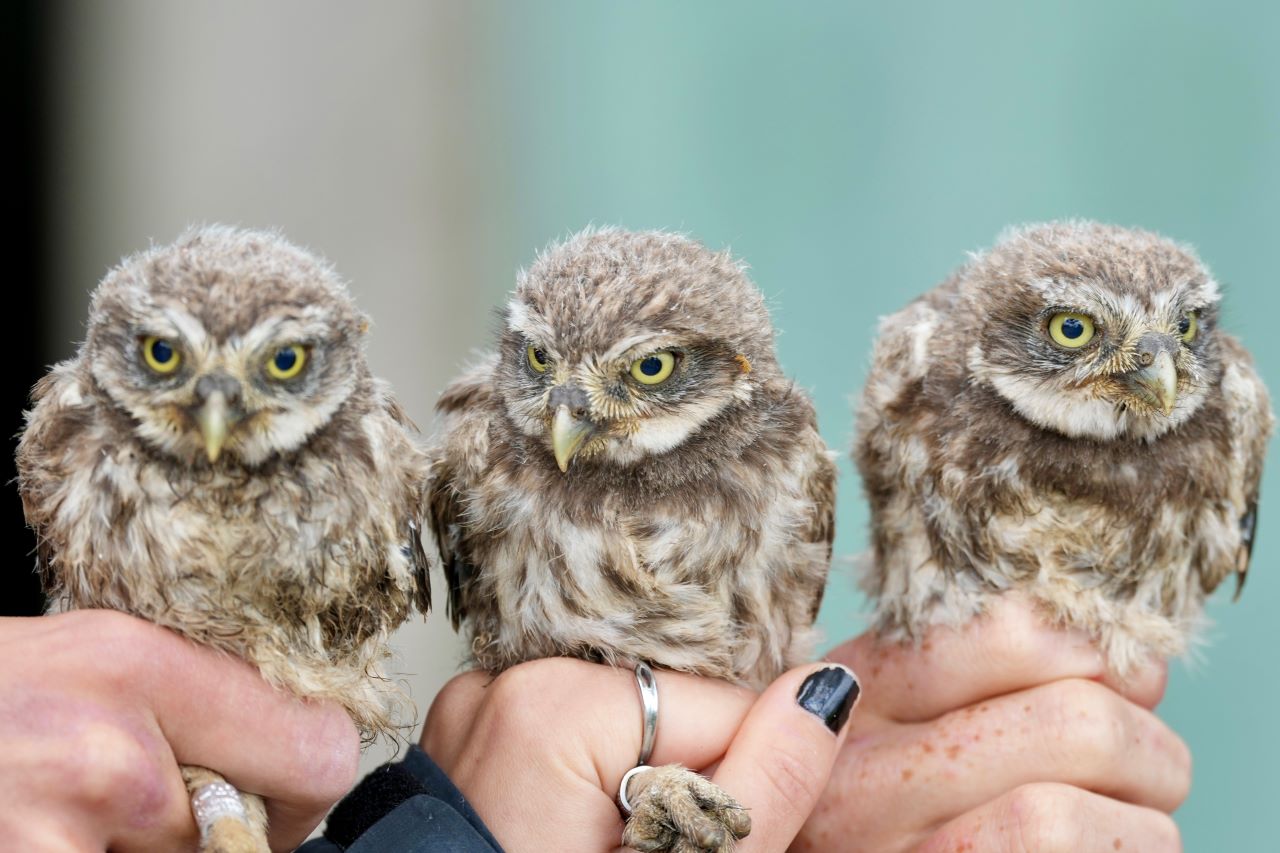
Triplets. Photo by: Søren Leth-Nissen
Luckily, this was not the only surprise in store for us this afternoon… rumour had it there were also Eurasian Kestrel (Tårnfalk) chicks (pulli) in a birdbox in the side of the shed, and the best part? We could ring them! These little ones were a lot less calm than the Little Owls (Kirkeugle), but they cooperated nonetheless, becoming all blinged up with a new shiny ring.
Seán holding a Eurasian Kestrel (Tårnfalk) chick (pull).
Isis holding a Eurasian Kestrel (Tårnfalk) chick (pull).
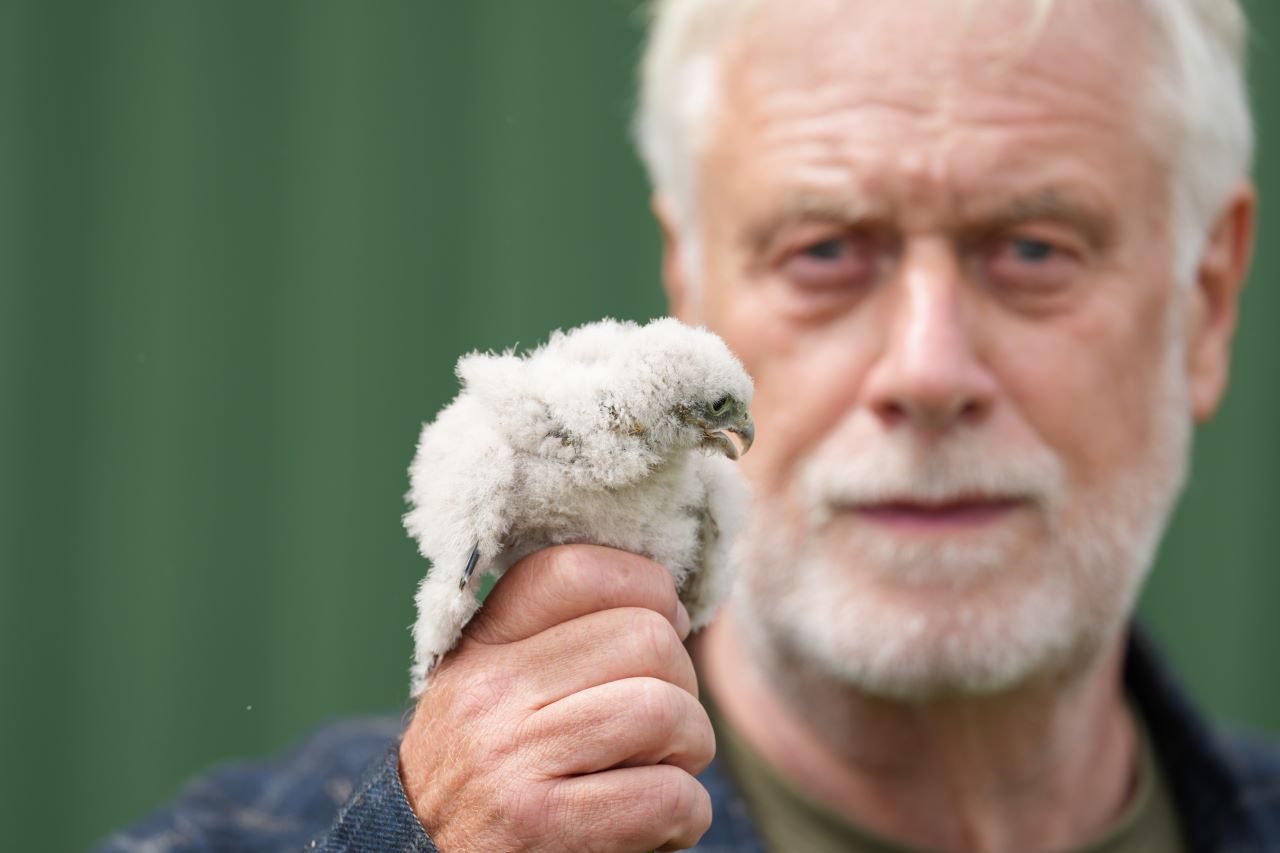
Lars Bo holding a Eurasian Kestrel (Tårnfalk) chick (pull). Photo by: Søren Leth-Nissen
After we had finished working with the birds, the landowners kindly invited us into their home for cake, coffee, and tea. Their garden was beautiful, the cake was absolutely delicious, and the company made the experience one of most cherishable value. Mange tak!
Once we were on the road again, we had a new objective: Black-Winged Stilts (Stylteløber) and maybe some Golden Eagles (Kongeørn). So we set the GPS for Biersted and off we were. Once we got there, Mette quickly spotted the Black-Winged Stilts (Stylteløber) and we all got a perfect view (and many pictures) of them. That was fun! Then we met up with a local birder, Morten, and he took us to see the Golden Eagles (Kongeørn). Simon (Jr) cleverly spotted one perching, and again, we all got a great look at the bird.
Biersted Mosevej.
What a successful day!
On the car ride back to the station there was a lot of debate, should we get fast food? Should we do groceries? What will we do for dinner! In the end, we agreed upon a quick round of groceries, and Simon (Jr) whipped up a super speedy, super delicious, and super filling dinner followed up by some tiramisu for dessert.
Hej hej!
Today’s observations in Dofbasen from observers in the area.
Sum of the raptors in the area based on observations typed into Dofbasen the same day.
People: Seán Walsh, Isis Khalil, Magnus Houen Lauritsen, Simon Kiesé, Simon S. Christiansen, Søren Leth-Nissen, Lars Bo, Mette
When does summer start?
At this point of the SPRING season, there is one question we have to dicuss out of the birders point of view. When does the summer start?
After having many very warm days in May, the last days were a bit chilled. This is very typical for June, but is it already summer in anyway?
Weatherwise I would say, that summer starts, when it gets warm after this weather period. But birdwise we can define it different. Therefore we should look at the birds from this morning.
Ringing today still brought some new birds, but the big surprises were missing. We ended up ringing a bit over 20 birds. Even slower days in the ringing are nice, because you have more time to examine the moult of the birds and discuss every single bird. Magnus ringed a lot today and gets better in the ringing process from bird to bird. His measurements are really good!
We also caught and recaught some first calenderyear Chiffchaffs (Gransanger). Young birds, is that a sign of spring?
Seán was counting today. Some Fulmars (Mallemuk) were migrating, otherwise it was really slow. The highlight was a singing Golden Oriole (Pirol), we could also hear from Kabeltromlen. Slow counts - is that a sign of summer?
One Greenshank (Hvidklire) was migrating today, this is the first sign of autumn migration. If autumn has started, springs must have stopped, right?
So is it summer now? I think so!
While we slept, ate and entered data, the bord members of the Bird Observatory had a meeting. It was nice to see them again and Simon Sr's boss Jacob stays with us for one night. He was already a guest in autumn in the apartment and it is really nice to talk to him again.
Ringing (Kabeltromlekrattet):
Total: 22
A link to today's observations from volunteers and local observers.
Sum of observations of raptors on DOFbasen from today.
Seán Walsh, Isis Khalil, Magnus Houen Lauritsen, Simon Kiesé, Simon S. Christiansen and Søren Leth-Nissen, Jacob Jensen.
Bird-decorated nets, rare orchids and butterflies makes the day
Hi and welcome to the Blog in a day, that should turn out to be a bit more unusual than the former weeks. For the first time in weeks, we barely had any wind, and barely any clouds in the sky. It should turn out to be the recipe of the most busy count for maybe a month.
But we will start back at the lighthouse, where I did data-checking, raptor summary and checked raptor summaries for five hours yesterday evening, before heading for bed at around 00.00. My alarm rang at 03.15. The reason for the unusually early alarm was our suspicion of it being a good day for Fulmars (mallemuk). The reason why our suspicion was because of the slow winds, which - after periods of stronger westerly winds - usually means the fulmar migrate out of Kattegat towards Skagerak (NV).
Unlike earlier days, we turned out to be terribly wrong. It was just as slow as the average days the last few weeks. Corn Bunting turned out to be the best bird for four hours of counting
The count were quite a contrast compared to the ringing. A total of 54 birds were ringed today. That’s approximately 30-35 birds more than the daily catches the last few weeks. For that reason, we ringed for six hours, before closing. The best bird was a Brambling (kvækerfinke), which were late, compared to when they usually turns up.
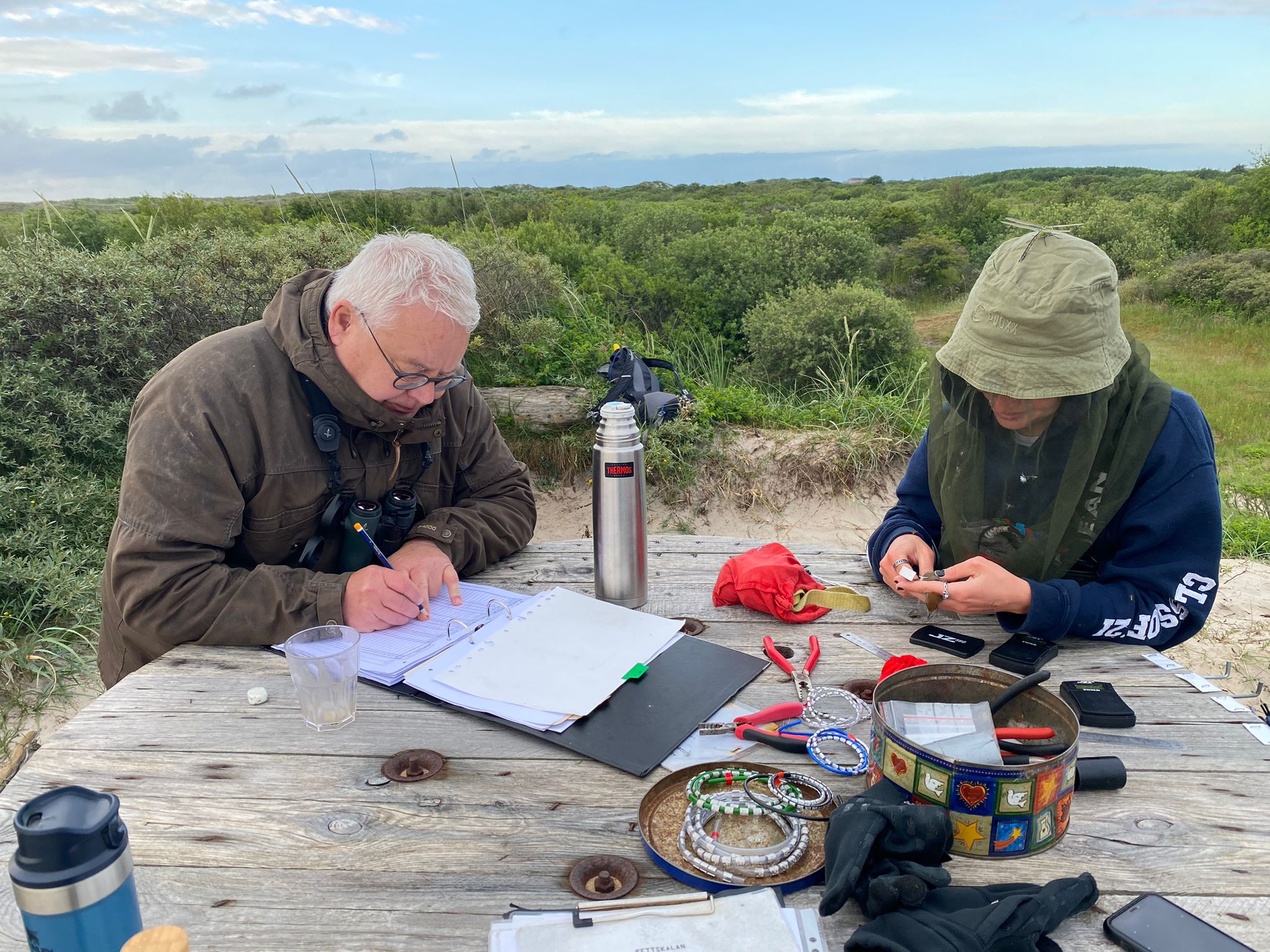
Isis ringing. Søren takes notes. Photo: SSC.
We headed back to the station and had some lunch. Some had a nap, but I was called by a friend of mine, who informed me that Anders and Dorte were back in Skagen, after a trip by bike all around the Danish coastline, visiting plenty of the unique lighthouses Denmark has. I joined my friend at the driveway to the grey lighthouse, where we welcomed Anders and Dorte, and congratulated them with their performance with champagne.
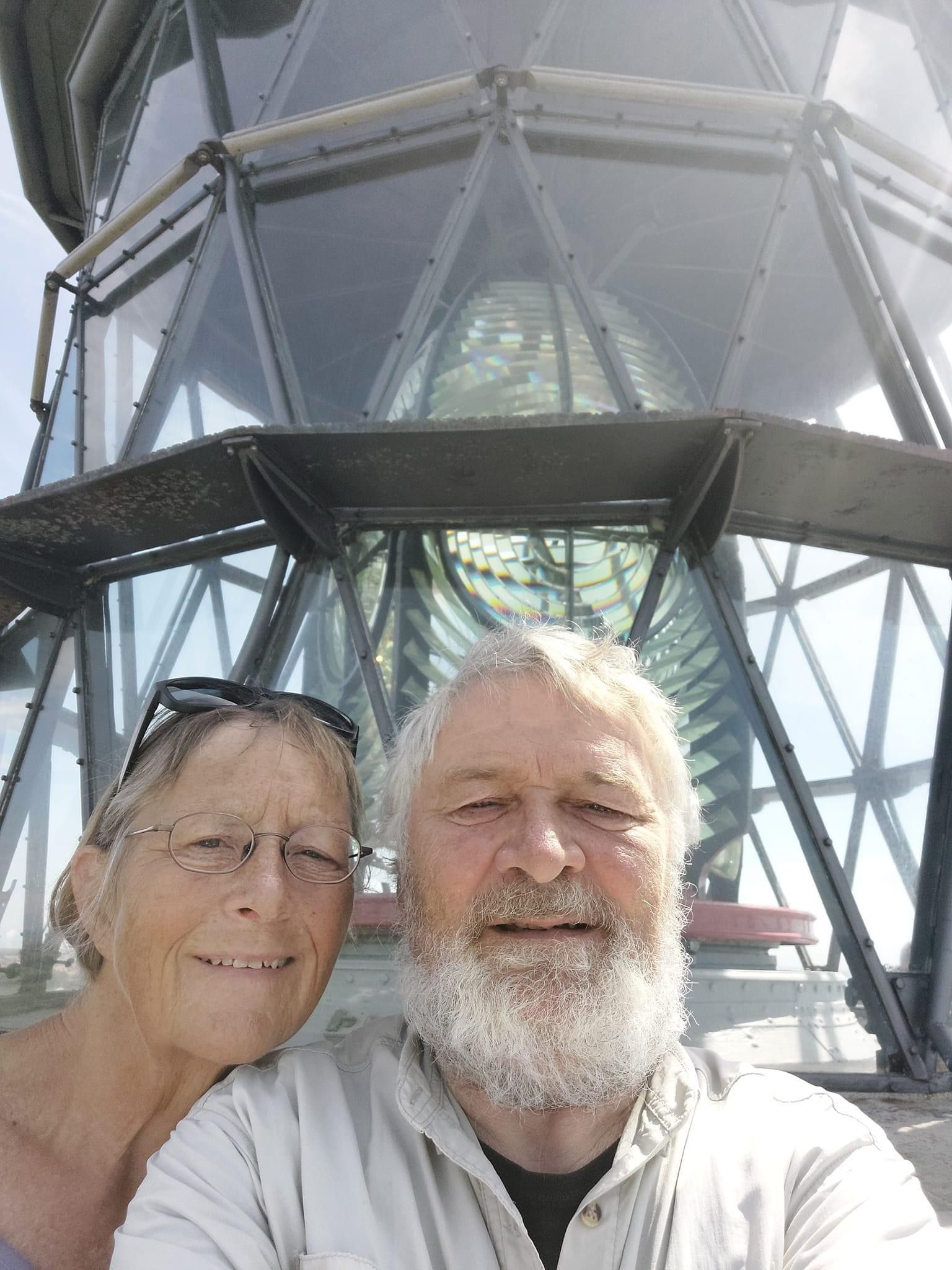
Anders and Dorte climbed the stairs to the tip of the lighthouse, to shoot the last lighthouse-selfie of their trip. Photo: Anders Østerby.
Their lighthouse trip has the goal to inspire to explore the country in a green way and recommend followers to support some of the places they visitied. Skagen Bird Observatory has MobilePay number: 39357 in case you would like to support the work we do here.
My friend and I headed for the non-lethal beetle traps shortly after, to check if the extremely rare (maybe extinct) Calosoma auropunctatum was caught. To our big disappointment, none had gone into the traps, and only an area nearby with rare butterflies were able to lift the mood. We counted around 12 of the rare Marsh Fritillary - hedepletvinge (Euphydryas aurinia), 1 Amandus’ Blue - isblåfugl (Polyommatus amandus), and 3 Purple-edged copper - violetrandet ildfugl (Lycaena hippothoe).
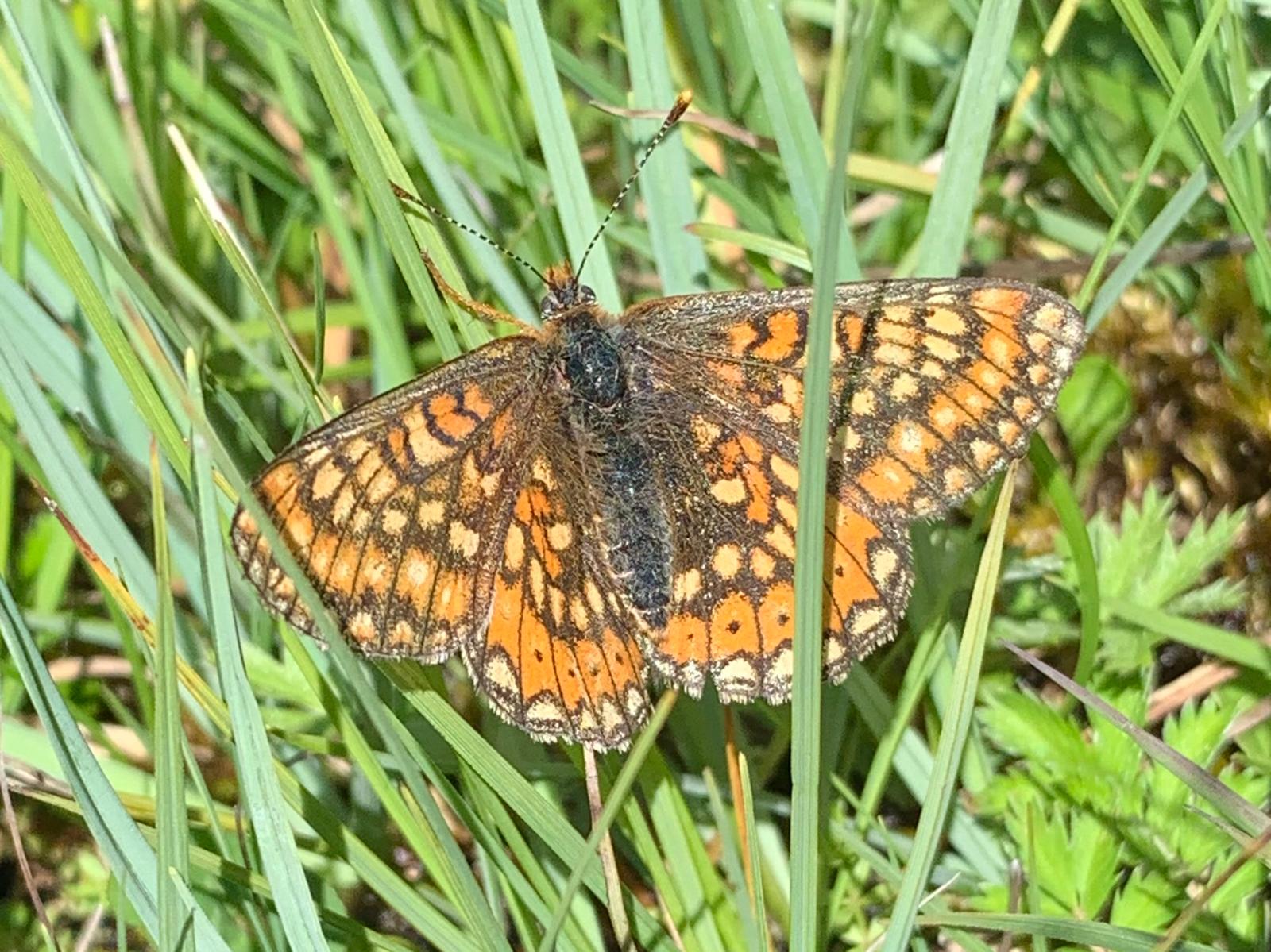
Marsh Fritillary - hedepletvinge (Euphydryas aurinia). Photo: Simon Kiesé.
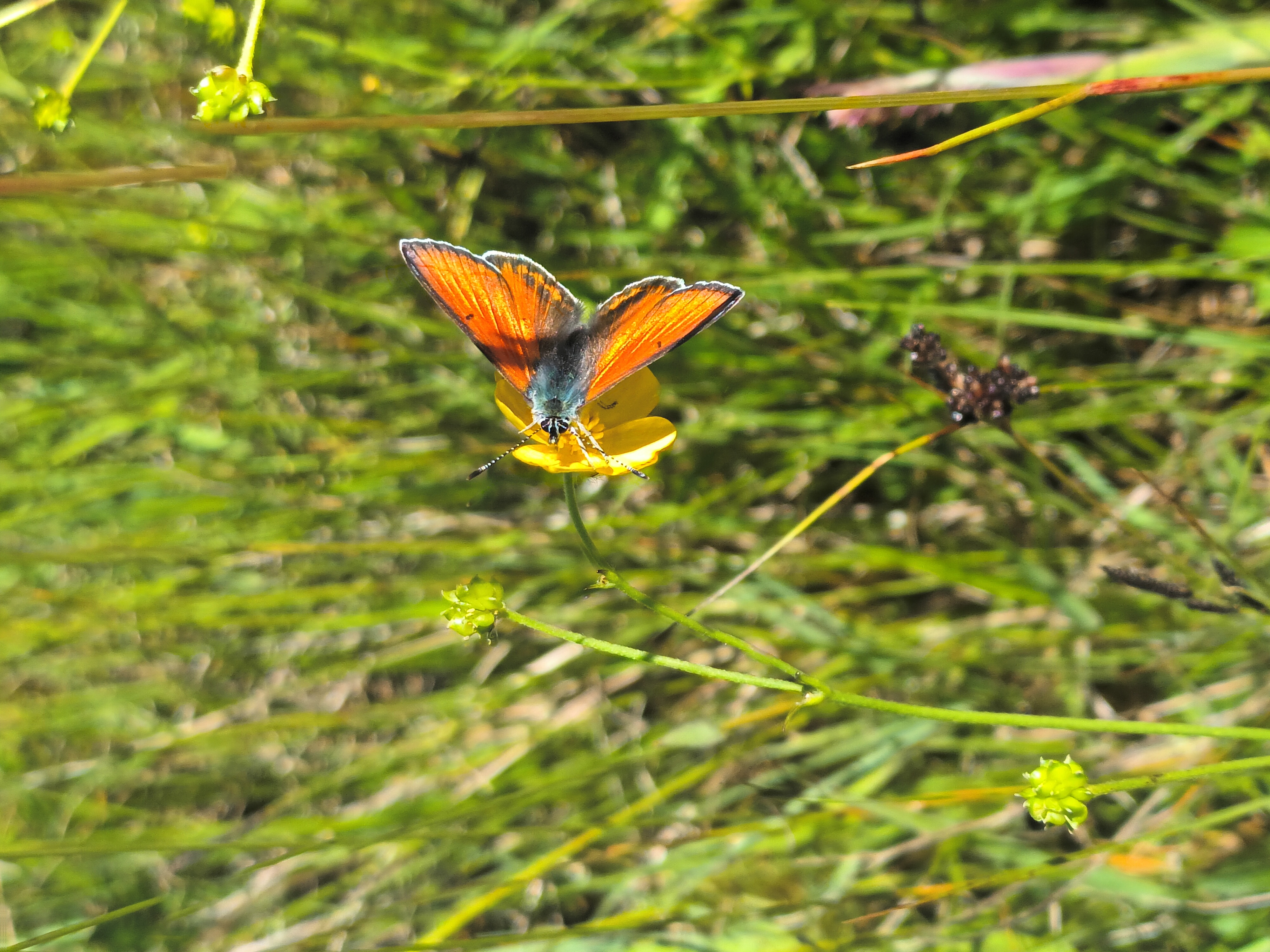
Purple-edged copper - violetrandet ildfugl (Lycaena hippothoe), Male. Photo: Magnus Houen Lauritsen
Also great numbers of orchids were to find as well. Hundreds - maybe thousands of Heath Spotted Orchid - plettet gøgeurt (Dactylorhiza maculataf), a few hundreds of the northern marsh orchid - purpur-gøgeurt (Dactylorhiza purpurella), and a few handfuls of lesser butterfly-orchid - bakke-gøgelilje (Platanthera bifolia).
We stopped on our way back, to check the industry area for rare birds, but without luck. We were back at the station at 17.30, having an evening meeting until 18.30. I started cooking risotto shortly after. Dinner was at around 19.45 and we finished cleaning the dishes at around 21.00. At that point, I’ve had three hours of sleep in the last 30 hours.
But my daily tasks weren't done yet. I began writing the Blog for the day, but ended up falling asleep at around 23.30. I found myself on the couch the next morning at 02.30 ready to head out to open the nets.
Therefore are the last few lines of this Blog written after six hours of sleep and 46 hours of being active.
Maybe I should’ve done one more raptor summary? Probably.
/Magpie/Krøllebille/Magnus/MHL.
Ringing (Kabeltromlekrattet):
| Reed Warbler |
Rørsanger | 7 | RI | ||
| Blackcap | Munk | 24 | RI | ||
| Chaffinch | Bogfinke | 2 | RI | ||
| Common Whiterhroat | Tornsanger | 4 | RI | ||
| Marsh Warbler | Kærsanger | 6 | RI | ||
| Wren | Gærdesmutte | 2 | RI | ||
| Robin | Rødhals | 1 | RI | ||
| Sedge Warbler | Sivsanger | 1 | RI | ||
| Chiffchaff | Gransanger | 4 | RI | ||
| Garden Warbler | Havesanger | 2 | RI | ||
| Brambling | Kvækerfinke | 1 | RI |
Total: 54
A link to today's observations from volunteers and local observers.
Sum of observations of raptors on DOFbasen from today.
Seán Walsh, Isis Khalil, Magnus Houen Lauritsen, Simon Kiesé, Simon S. Christiansen and Søren Leth-Nissen,
